

List: Top Picture Books For Upper Primary Students
Picture books aren’t just for young readers, they’re important for the literacy learning of older kids too.
But as a teacher or parent, which picture books can you use to engage upper primary aged children? On Episode 34 of the Teacher’s Tool Kit For Literacy podcast, experienced upper primary teacher Giselle Pulford hand picked her top book recommendations.
Read the list below and check out the books via the links provided.
Picture books that are Tantalising Texts …
Stories that engage older students, make them wonder, question and laugh in surprise.

· The Mysteries of Harris Burdick by Chris Van Allsburg
· Sam and Dave Dig a Hole by Mac Barnett and Jon Klassen
· After the Fall by Dan Santat
· The Word Collector by Peter Reynolds
· Help! I’m Falling Apart / Help! I’m Cracking Up! by Tedd Arnold
· Maths Curse / Science Verse by Jon Scieszka and Lane Smith
… leading to True Tasks …
Rich language experiences, content related but driven by the books.

· Little Mouse’s Book of Fears by Emily Gravett
· The Highway Rat by Julia Donaldson and Axel Scheffler and
· The Highwayman by Alfred Noyes, Charles Keeping version
… leading to Transformative Teaching …
Layers of a picture book, which can fit to where students are now.

· The Bad Seed / Good Egg / Cool Bean / Couch Potato by Jory John and Pete Oswald
· The Fabulous Friend Machine by Nick Bland
· Welcome by Barroux
… leading to Thinker’s Talking:
What do these books tell us? What do they leave us with? Students can see themselves in these stories, they can relate to the experiences, and can be forced to shift their perspectives and understanding.

· Room on Our Rock by Jol Temple and Kate Temple
· Weslandia by Paul Fleischman and Kevin Hawkes
· Last Stop on Market Street by Matt de la Penã and Christian Robinson
· Milo Imagines the World by Matt de la Penã and Christian Robinson
· The Proudest Blue by Ibtihaj Muhammad and SK Ali
· Your Name is a Song by Jamilah Thompkins-Bigelow and Luisa Uribe
· The Rabbits by John Marsden and Shaun Tan
· Welcome to Country by Aunty Joy Murphy and Lisa Kennedy
· Cooee Mittigar by Jasmine Seymour and Leanne Mulgo Watson
· Finding our Heart by Thomas Mayor and Blak Douglas
And last but not least, the final recommendations:
· The Koala Who Could by Rachel Bright and Jim Field
· Here We Are and What We’ll Build by Oliver Jeffers
Do you have picture books that you would recommend for upper primary readers? We would love for you to share them with our active community of motivated teachers in the Teacher’s Tool Kit For Literacy Facebook Group. Request to join here .
You can listen to the full discussion with literacy expert Sharon Callen, and Giselle below, and remember to subscribe on your favourite podcast player.
Want to accelerate literacy learning at your school? Let’s talk .
Recent posts
Part 4: high impact strategies for struggling readers, years 3 to 6 - effective book selection (2), part 2: high impact strategies for struggling readers, years 3 to 6, part 3: high impact strategies for struggling readers, years 3 to 6 - effective book selection.
How can we help? Let’s chat about your literacy learning goals and needs.
Email [email protected]
Equipping, empowering and supporting teachers to become their authentic selves

Classroom Management
Community building, virtual teaching, the one with must have picture books for upper elementary.
I’ve always loved using novels in the classroom, but in more recent years, I’ve recognized the power of picture books. They’re short and easily have multiple ways to be used in the classroom. They can be inspirational and mentor texts. While virtual for most of 2020-2021, I relied heavily on picture books because they were much easier to share with my students.

This is my MUST HAVE picture book list for every upper elementary classroom. I’m constantly adding new books, but these are ones I’ve come back to or used in multiple ways. With each title, I’m adding a little snippet to give you some ideas for how to use these in your class. These are in no particular order, just however I thought of them.
Each book is linked to Amazon. You can also find the whole collection in my shop . BUT if you need ideas for how to buy without spending $$$, check out this blog post.
- Do Unto Otters : review manners with students, discuss “golden rule” and terms like cooperation and respect.
- We Don’t Eat Our Classmates : discussing empathy and what it means to be the new person. And it includes a dinosaur
- Our Class is a Family : how our class is like a family, defining families and how we need to function as one. It also shows great illustrations of how families look very different!
- Your Name is a Song : the beauty of identity and how your name is important, also why we need to pronounce names correctly. The author created a YouTube video that helps readers pronounce the characters’ names, which emphasizes their importance.
- Miss Malarkey Leaves No Reader Behind : character trait of perseverance, plus I always say I’m like Miss Malarkey because I’m obsessed with reading and will always try to find something they like.
- Our Subway Baby : fabulous TRUE story about the adoption of a boy by two men, love the representation plus we talk about how families can look different.
- 28 Days: Moments in Black History that Changed the World : This is a favorite for Black History Month. Each day represents a different person or event in Black history. While we celebrate BIPOC all year long, I use this book as a special 5 min focus each morning of February.
- Ada Twist, Scientist : theme- curiosity & women as scientists, plus I love Ada’s drive, even at a young age! There are also other books in this series that students enjoy.
- What Should Danny Do? : this is a choose-your-own-adventure type book about making good choices. Fun way to remind students how our choices affect each part of our day. There is also a school and vacation version. I had a class that wanted to choose all the negatives to see what would happen. It was fun to make that connection!
- The Night I Followed the Dog : Funny story about how a boy who follows his dog one night and goes on a big adventure. Great for discussing parts of a narrative in addition to inspiring creative writing. We use the prompt “The Night I Followed…” and students write about their own pet or favorite animal. Here’s a blog post that talks more about it.
- When Aiden Became a Brother : identity and gender is an important theme here. Aiden is so thoughtful and kind towards his future sibling!
- Before She Was Harriet : Harriet Tubman was an epic woman. This non-fiction book is BEAUTIFUL and reflects the theme of identity, because Harriet Tubman was so much more than an Underground Railroad conductor.
- I’m Trying to Love Math : I love when I can find a book related to another subject. This book has multiple purposes. It shows all the reasons why math is an important subject, which is great for reluctant learners. Also, it’s great for an opinion writing piece on math (or any subject!).
- The Day You Begin : Jacqueline Woodson is simply amazing. This book is about acceptance and differences. It also pushes students to share so we can connect to each other. Great for encouraging sharing during community meetings.
- The Fantastic Flying Books of Mr. Morris Lessmore : This book shows how we all have a story and they’re all important! It’s great to start personal memoirs/narratives and to show the power of books.
- Counting on Katherine : A non-fiction favorite, this is great for a biography example, modeling taking notes, showing perseverance and discussing racism and women in math. The best part…explaining Katherine’s job as a computer.
- How to Read a Book : I can never decide if I like the poem or the illustrations best. Encouraging kids to read however they want, using poetry exploding with figurative language, and inspirational art is a powerful combination.
- Lift : The illustrations and graphic novel style of this text are what make it EPIC. A girl goes on an imagination adventure in the elevator. There are very few words, which makes it perfect for making inferences about visuals. It’s also great for launching writing!
- A Bad Case of Stripes : This is one I keep going back to as a mentor text. Camilla is a great person to explore character traits, how a character changes over time, and theme (be yourself!).
- Memoirs of a Goldfish : Another mentor text extraordinaire! This story is told from the point of view of a goldfish, in diary form. The goldfish learns to accept change and friendship by the end. Great for using as a writing prompt. (Check out this free resource I made and this blog post about more point of view activities .)
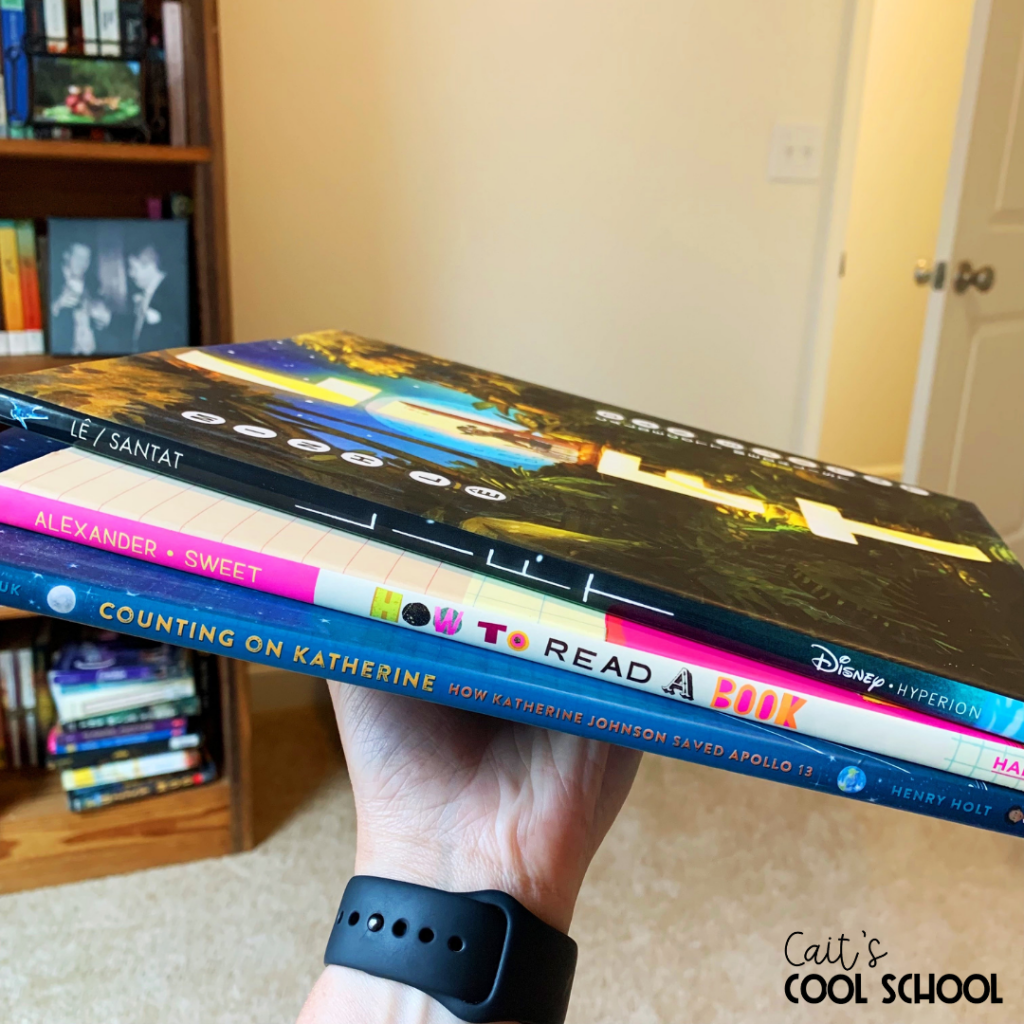
The first five books are a huge part of my beginning of the year classroom management strategy. For more about that, see this blog post. The other books are sprinkled throughout the year, based on what we’re learning or needing. Many of these are brought up multiple times, by myself and also by my students! Even when I switch up our mentor texts, they’ll bring us back to one of these, which is how I know these books are keepers.
Check out this entire collection of books in my Amazon shop here . What books would you add to my list?
Not ready to spend too much? Check out this blog post for how to build your classroom library without blowing your budget.
P.S. Are you working on building community this year? Try these free morning messages !

- Read more about: picture books , read alouds , reading , upper elementary
You might also like...

Seven Ways to Assess Comprehension for a Novel Study

Five Novels for Teaching Character Traits
Strategies for adding details and using elaboration in writing.

Looking for Something?
- Privacy Policy
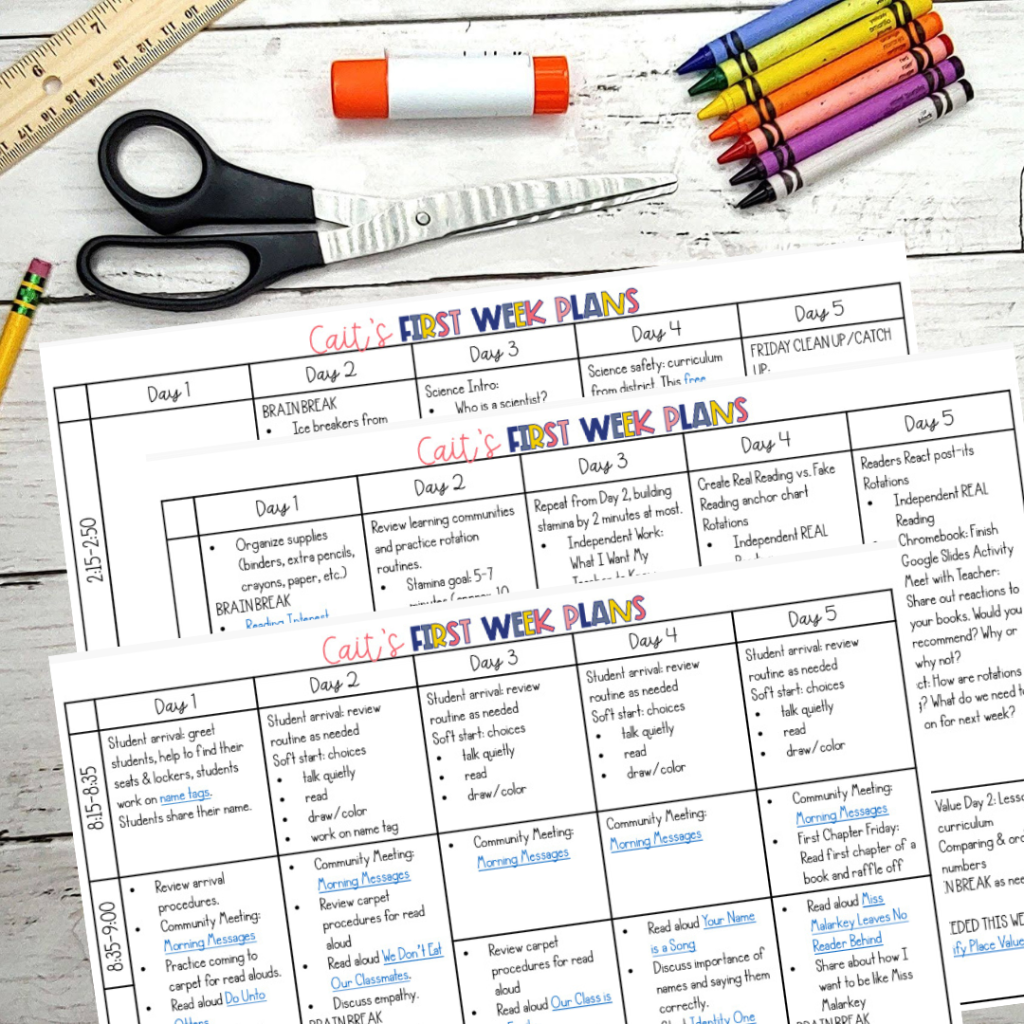
Have you heard? Get back to school ready now.

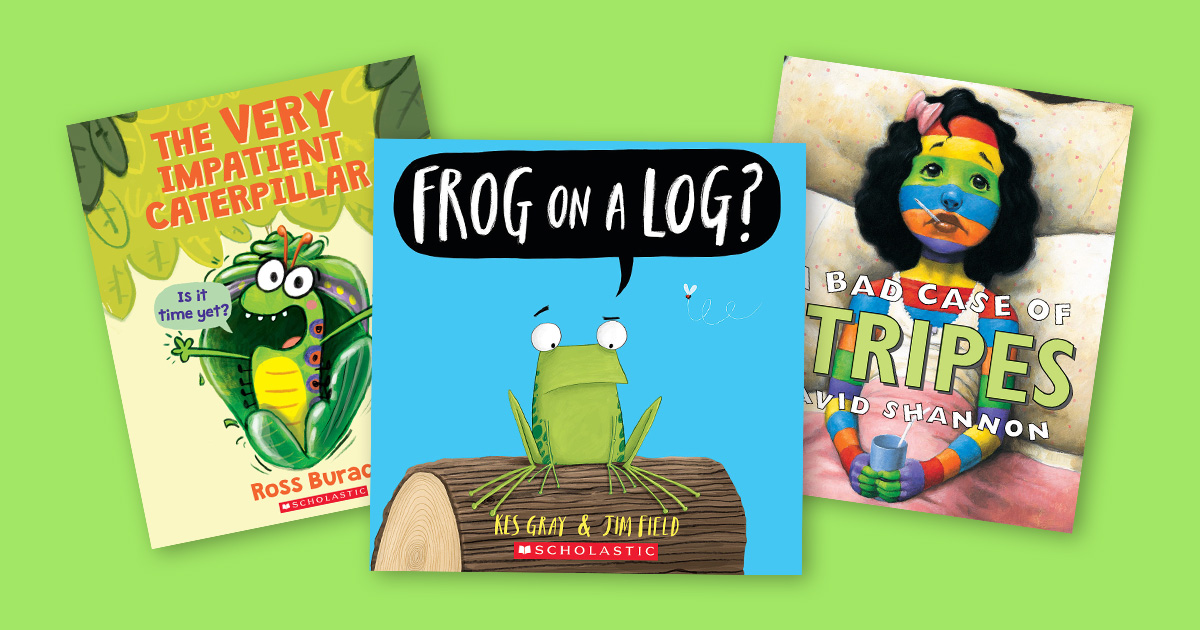
With cherished classics and contemporary award winners, written and illustrated by the superstars of children's literature, these popular picture books are sure to delight readers — young and old — for generations.
Picture books are a timeless way to engage your students with a multisensory experience that can help increase vocabulary, understand sentence structure, and encourage story analysis. Plus, the visual stimulation they offer young children can help them decode the narrative, which in turn increases comprehension.
Where the Wild Things Are , The Snowy Day , Corduroy , and Clifford the Big Red Dog are just a few of the beloved classic picture books featured in this list, along with popular new additions like The Very Impatient Caterpillar , A Bad Case of Stripes , and Frog on a Log?
Shop top picture books below! As an educator, you get at least 25% off the list price when you shop books and activities at The Teacher Store .
Want more great content? Subscribe to our Teacher Newsletter below and get teaching ideas delivered right to your inbox .
- Skip to main content
- Skip to primary sidebar
Pre-order my book and get a free bonus! LEARN MORE
The Measured Mom
Education resources for parents and teachers
PS PK K 1 2 3 14 Comments
15 Strong picture books for grades 3-5
This post contains affiliate links. As an Amazon Associate I earn from qualifying purchases.
Sharing is caring!
- Pinterest 2355
This post contains affiliate links.

Picture books? In grades 3-5?
You bet! Many teachers find strong picture books to use as interactive read alouds – and you can, too. In fact, I wrote a post all about how using picture books to build comprehension in the intermediate grades – you can read it here.
Today I’m sharing 15 strong picture books that you can use in your third, fourth, or fifth grade classroom; many of them would certainly work in primary classrooms, as well. Some of the texts are long, and some are short. Some have simple vocabulary, and some use more complex language. But here’s one thing they all have in common: they’re excellent for promoting discussion and building comprehension.
Strong picture books for grades 3-5
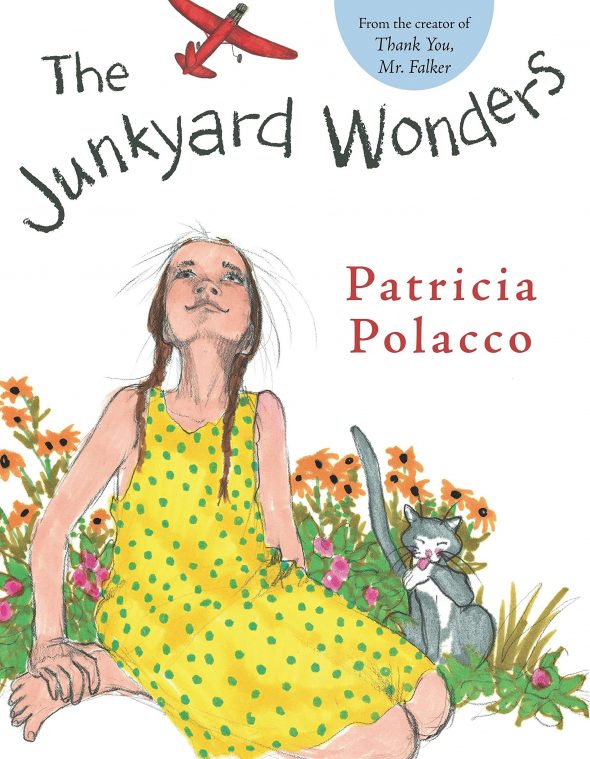
The Junkyard Wonders , by Patricia Polacco guided reading level: P
Patricia Polacco is a go-to author for strong picture books for kids in the intermediate grades. Her books are long but engaging, and they often address difficult topics. This is a story from Polacco’s own childhood, in which she is placed in the “junkyard” classroom because she is not a strong reader. But with the help of her inspiring teacher and her brilliant classmates, Trish learns that she and her classmates are true wonders. HIGHLY recommended.

Emmanuel’s Dream , by Laurie Anna Thompson & Sean Qualls guided reading level: N This is the true story of Emmanuel Ofosu Yeboah, who was born in Ghana, West Africa, with one deformed leg. In a country where people with disabilities are expected to become beggars, Emmanuel reached for his dreams. As a boy he hopped more than two miles each way to school – on one foot! Years later, he cycled 400 miles around Ghana – spreading the message that disability does not mean inability, and that people with disabilities are entitled to the same rights as other citizens.

The Sweetest Fig , by Chris Van Allsburg guided reading level: P
Monsieur Bibot is a cold-hearted dentist who cares only for himself. When a patient pays him with two figs “that will make your dreams come true,” he angrily sends her away without pain medication. But Bibot soon discovers that when he eats a fig in the evening and wakes up the next day, his dreams from the night before do come true! Marcel has great plans for the second fig, but someone else gets to it first. Kids will love how justice is served in this engaging story.

Star of Fear, Star of Hope , by Jo Hoestlandt
This is a powerful, yet gentle book about the Holocaust. Told from an old woman’s perspective, Helen regrets her last interaction with her childhood best friend. She was angry that her friend left her birthday party early, only to discover the next day that her friend’s family was rounded-up and arrested in a Nazi raid. The book will definitely provide opportunities for deep conversations.

Thank You, Mr. Falker , by Patricia Polacco guided reading level: M
I’m sure my kids would not enjoy me reading this book to them because it makes me cry every time. It’s the beautiful true story of its author, Patricia Polacco. School was torture for Patricia as she struggled to make sense of letters and numbers. She was horribly teased and would hide in a dark stairwell rather than be subject to the other children’s cruelty at recess. But her kind fifth grade teacher discovered that she had dyslexia – and with his help and dedication, she became a reader.
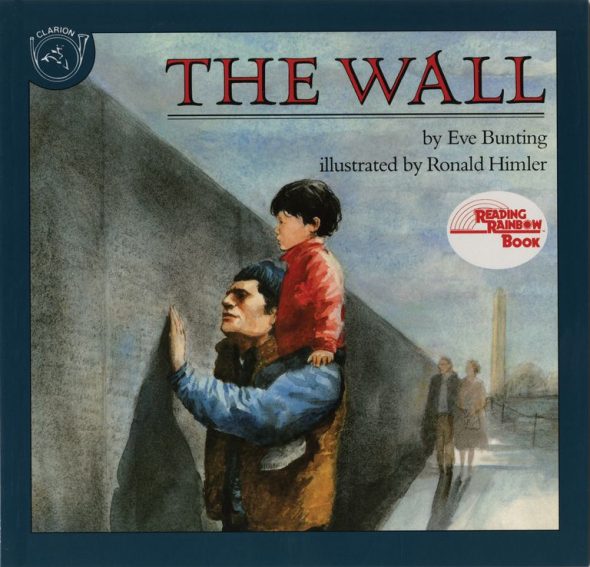
The Wall , by Eve Bunting guided reading level: P
This is a moving book about a boy who visits the Vietnam Veterans Memorial with his dad. Together, they look for the name of the boy’s grandfather, who died many years ago when the boy’s father was young. A powerful, mesmerizing story.

Knock Knock , by Daniel Beaty Guided reading level: N
This is a very powerful, inspiring and very simple book. It’s about a boy who loves his father very much, only to be devastated when his father doesn’t come home. As he laments all the things he won’t learn from his father, he receives a letter from his dad encouraging him to lead a beautiful life.
We learn at the end of the book that the author’s father was incarcerated when he was a young boy.

Freedom Summer , by Deborah Wiles
This is a book about two boy who are friends in 1964; one is black, and one is white. The boys are excited when an anti-segregation law means that the town pool will finally be open to everyone. Sadly, the town fills the pool with concrete rather than allow integration. An honest yet hopeful book.
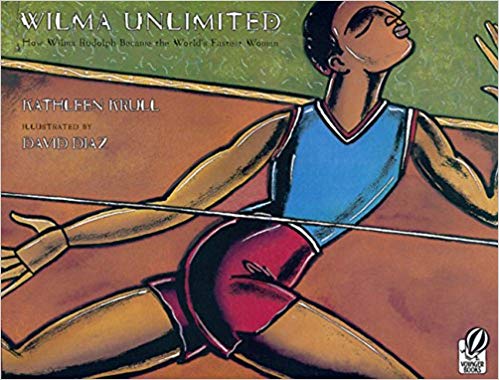
Wilma Unlimited , by Kathleen Krull Guided reading level: Q
This book tells the unbelievable story of Wilma Rudolph, the twentieth child born to a poor black family in 1940. At five years old, Wilma was stricken with polio. Her busy mother took a 50-mile trip with her each week to the nearest hospital that would treat black patients. After years in braces, Wilma learned to walk again. Then, at age 20, Wilma became the first American woman to win three gold medals at a single Olympics – for running! Reserve this book right now – it’s too good to miss!
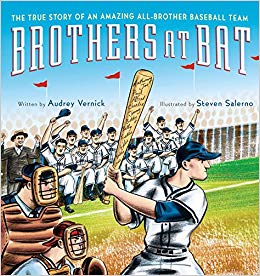
Brothers at Bat , by Audrey Vernick
I include this book as a break from the deeper topics in this list. It’s the amazing true story of an all-brother baseball team (there were 12 of them!). The book takes us from their childhood, through their years as a baseball team, their service during World War II, and finally their return to baseball and the having families of their own. An attention-keeper for sure!
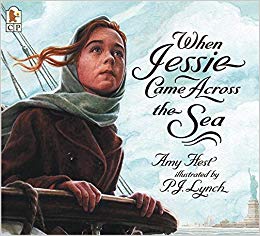
When Jessie Came Across the Sea , by Amy Hest Guided reading level: S
This is an unforgettable story about a young girl from a poor village in eastern Europe. She is devastated when she learns that she has been chosen to leave her grandmother and travel to America. But while there, she finds purpose and love.
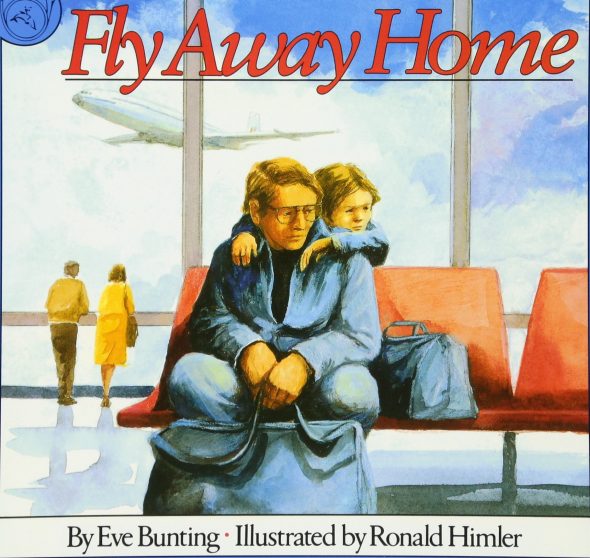
Fly Away Home , by Eve Bunting Guided reading level: P
This is a beautiful, simple story about a boy who lives with his father in the airport – always trying to avoid being noticed until they are able to get a home of their own. A wonderful book for teaching compassion and empathy.
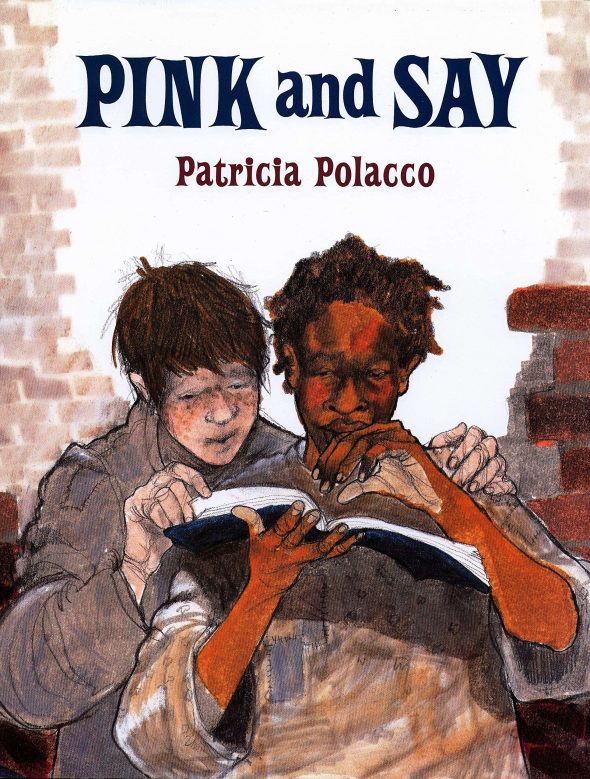
Pink and Say , by Patricia Polacco Guided reading level: V
In this true Civil War story, passed down through generations, Polacco shares tells of the friendship between two Union soldiers – one black and one white. I highly recommend this book for older listeners – but be prepared for the tragic ending.

The Cats in Krasinski Square , by Karen Hesse Guided reading level: V
Based on a true story, this book tells of a brave young Jewish girl who smuggles food to hungry Jews in the Warsaw Ghetto. It’s very hard to write about the Holocaust for children, but Hesse has done a masterful job. This is a great book to introduce children to a very dark period of history.

The Sunsets of Miss Olivia Wiggins , by Lester L. Laminack Guided reading level: Q
This is a gentle book that tells the story of a young boy who visits his great-grandmother in a nursing home. Miss Olivia Wiggins doesn’t speak and hardly moves, but she lived a rich and full life. Read this book to teach your students about dementia and to build compassion and empathy for the elderly.
Look for more posts in my series about reading comprehension in grades 3-5!
Free Reading Printables for Pre-K-3rd Grade
Join our email list and get this sample pack of time-saving resources from our membership site! You'll get phonemic awareness, phonics, and reading comprehension resources ... all free!

You May Also Enjoy These Posts:
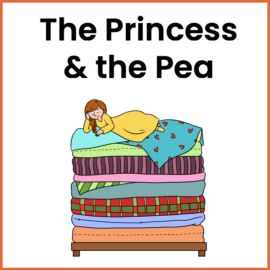
Reader Interactions
14 comments.
February 20, 2020 at 8:05 am
It’s to bad my library doesn’t carry any of these books
Andrea Saad
May 10, 2023 at 10:49 pm
Just a thought, but you could buy and donate this book for your library in honor of your favorite teacher or in your child’s name!
Debra Turner
April 20, 2019 at 6:08 pm
I noticed that the book The Other Side by Jacqueline Woodson is on your list. I have that one and love it, but there is another book by her that I also think is excellent. It is called Each Kindness, and it is one that often makes me cry. My students love the book as well, and many times they request to have it read again later during the year. It seems to have an impact on them. Check it out if you haven’t read it. I really think you’d like it, and it promotes lots of discussion about kindness.
April 26, 2019 at 1:38 pm
Thank you so much for that recommendation, Debra! I’ll have to check it out. 🙂
July 20, 2019 at 8:44 am
I love Each Kindness. I read every year to my claaa the first week do school.
April 20, 2019 at 7:30 am
Thank you for the book titles and brief summaries. There are a few I have never seen and I’m excited to see the discussions they will spark with my kids.
April 27, 2019 at 8:46 am
You’re welcome, Lisa!
April 18, 2019 at 10:52 pm
I had to laugh when I read that the one book there makes you cry. For the Love of Autumn by Patricia Polacco does that to me. Every. Time. Haha! She’s such a great author!
April 20, 2019 at 11:36 am
I don’t know that one, but I’ve requested it! Maybe I should read it by myself first, lol.
May 8, 2019 at 10:17 pm
Thank you very much for the list of books.
Jeanette Saenz
September 23, 2018 at 12:21 pm
Thank you very much for sharing your worksheets. I am a kinder e.a and love to help my kinders learn.
October 15, 2018 at 7:22 am
You’re welcome, Jeanette!
[…] […]
[…] […]
Leave a Comment Cancel reply
Your email address will not be published. Required fields are marked *
This site uses Akismet to reduce spam. Learn how your comment data is processed .
Science of Reading Resources
Popular freebies.
Get instant access to science of reading workshops and over 2000 printable resources!
Become a Member
Check Out the New Website Shop!

Novels & Picture Books

Anchor Charts

- Book Recommendations
- Picture Books
- Teacher Ideas
Incorporating Picture Books In Your Upper Elementary Classroom
By Mary Montero
Share This Post:
- Facebook Share
- Twitter Share
- Pinterest Share
- Email Share
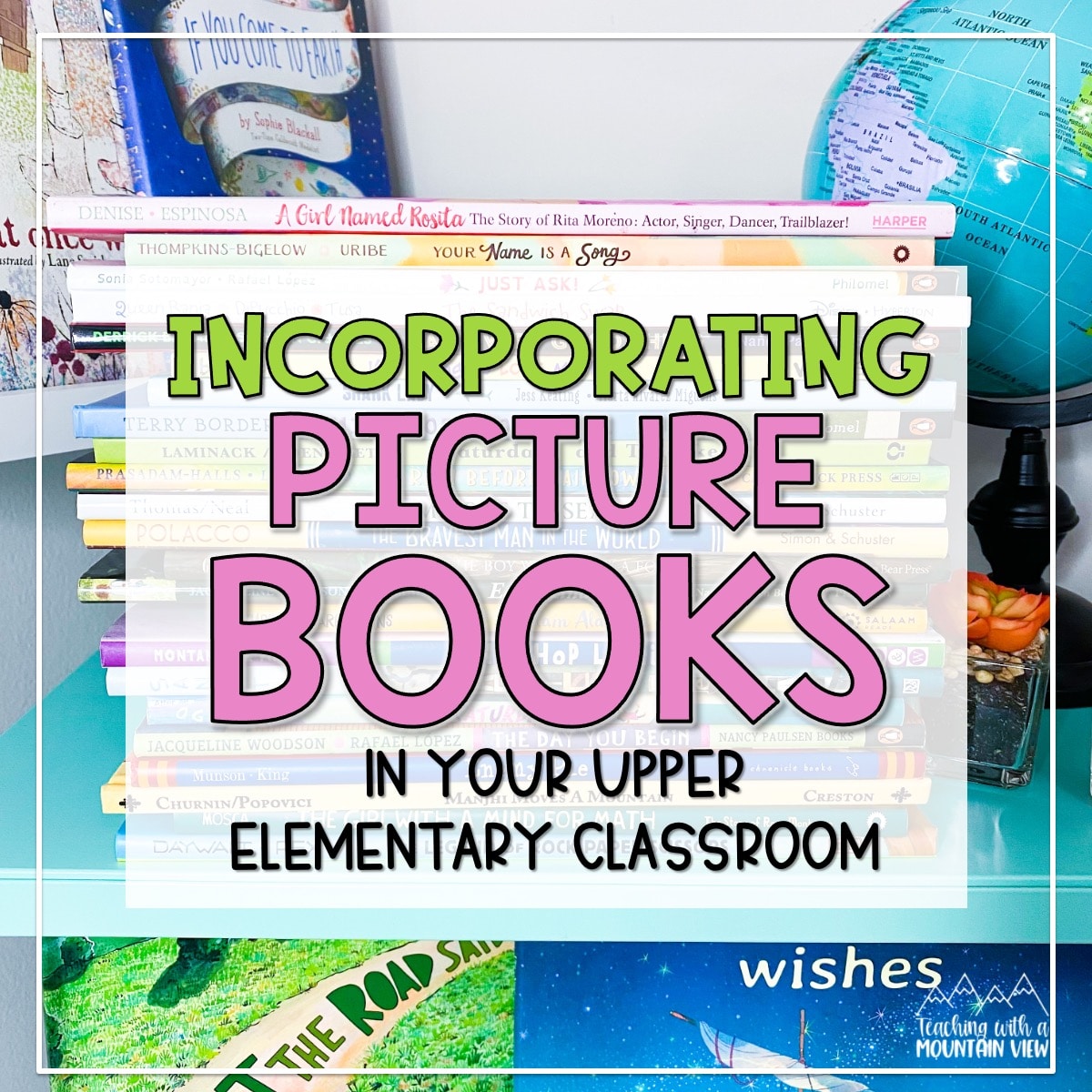
I love incorporating picture books in the upper elementary classroom as much as possible. There’s often a misconception that picture books are only for younger students, but they’re a great way to reinforce concepts for upper elementary students too. I always recommend reading each title once for enjoyment before re-reading it in order to do a deep dive into the lesson.
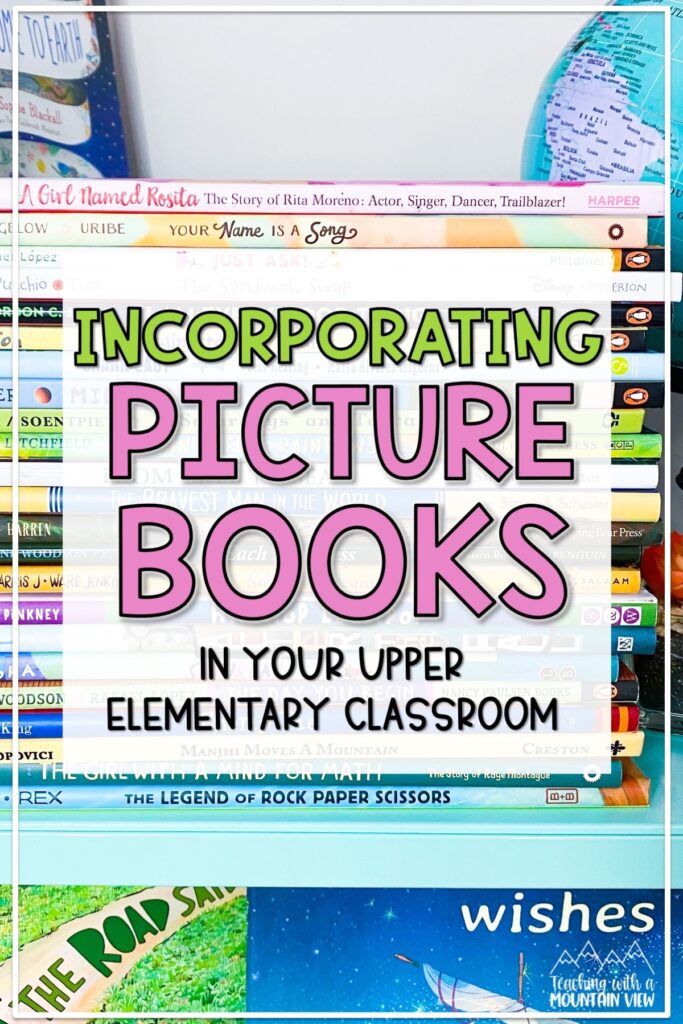
The links below are all Amazon affiliate links for easy shopping.
Excellent Picture Books
Picture books aren’t just for younger kids! Every single one of these books has been carefully selected with upper elementary students in mind. Tuesday and Flood are both wordless books, which I HIGHLY recommend using for inference. These are the cream of the crop when it comes to stunning illustrations that truly add to the written story and each of them can be used any time of the year.
- We are Water Protectors
- The Vanishing Lake
- A Different Pond
- Browse all titles on Amazon
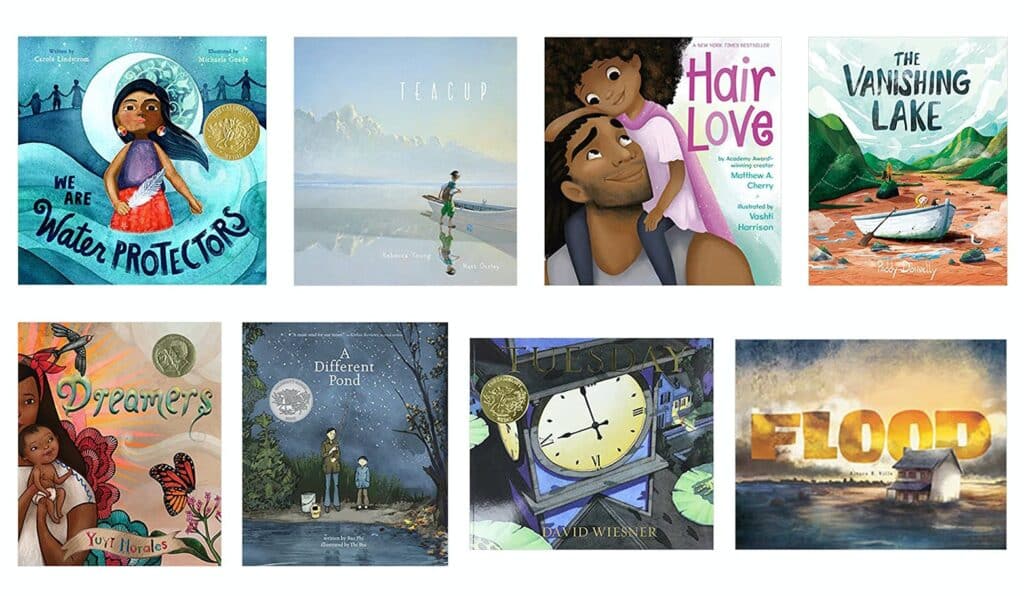
Related Picture Book Resources
- FREE Visualizing Reading Skill Task Cards
- Using Pictures for Reading Skills BUNDLE
Reading Skills
These books are perfect companions for teaching key reading skills.
- Sequencing: Manji Moves a Mountain
- Cause and Effect: Stuck
- Point of View/Perspective: Voices in the Park
- Inference: The Memory String
- Compare/Contrast: Tea With Milk
- Fact/Opinion: Saturday
- Author’s Purpose: The Watcher
- Theme: Blackout
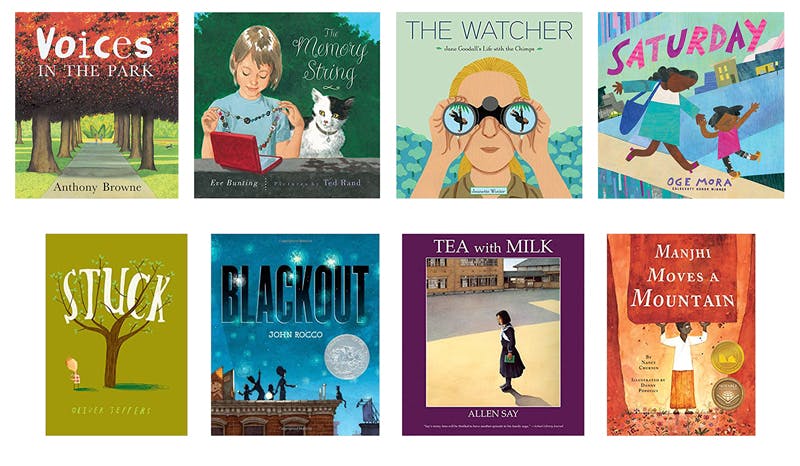
Related Reading Skills Resources
- FREE Reading Skills Quick Reference Guide
- Reading Skills Task Card Bundle
- Reading Skill of the Day
Informational Text Picture Books
Let’s talk informational texts: This was always an area where I felt like I could grow my classroom library. I had SO many bins of novels and picture books, and just one or two baskets full of informational text. My World Record books were always checked out, but other than that, students weren’t always gravitating toward the informational texts. It became really important to me to make sure I had high-interest, super engaging texts that they just couldn’t pass up. I don’t know about your students, but mine are OBSESSED with the Who Is/Who Was series and ANYTHING to do with fast and fun facts! These were a sure bet to get students reading nonfiction, so they are comprising my list of books today!
- Who Is/Who Was Box Set
- Interesting Stories for Curious People
- 50 American Heroes Every Kid Should Meet
- If the World Were a Village
- Bet You Didn’t Know
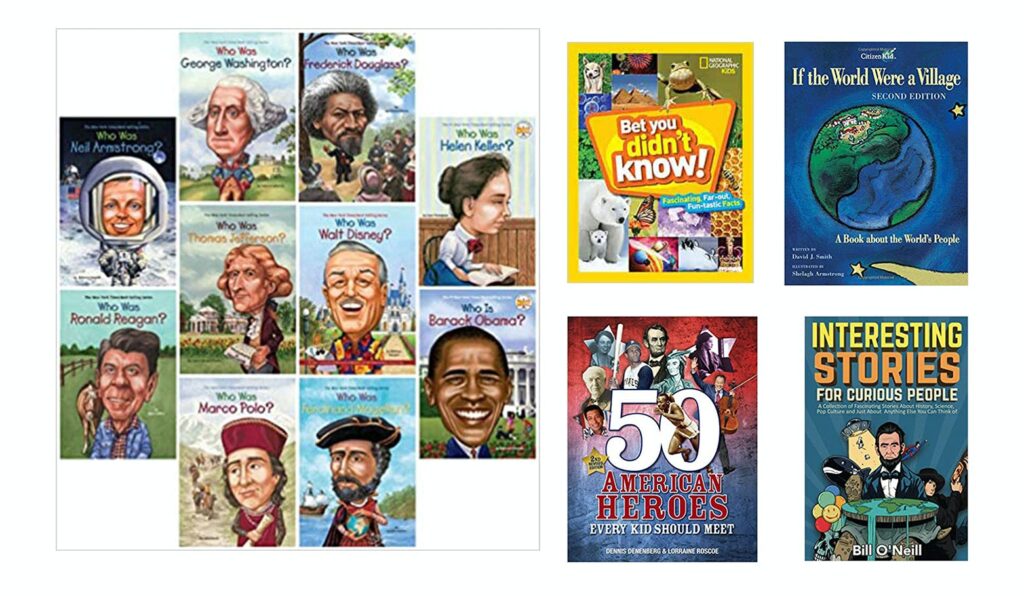
Related Informational Text Resources
- FREE Pre-Reading Task Cards
- FREE Open-Ended Reading Response Task Cards
- Reading Response Task Card Bundle
- Informational Text Reading Comprehension Passages
Figurative Language Picture Books
These titles are perfect for exposing students to rich language.
- Similes and Metaphors: Firebird
- Personification: The Legend of Rock Paper Scissors
- Hyperbole: Dona Flor
- Idioms: In a Pickle
- Alliteration: Animalia
- Onomatopoeia: The Remarkable Farkle McBride
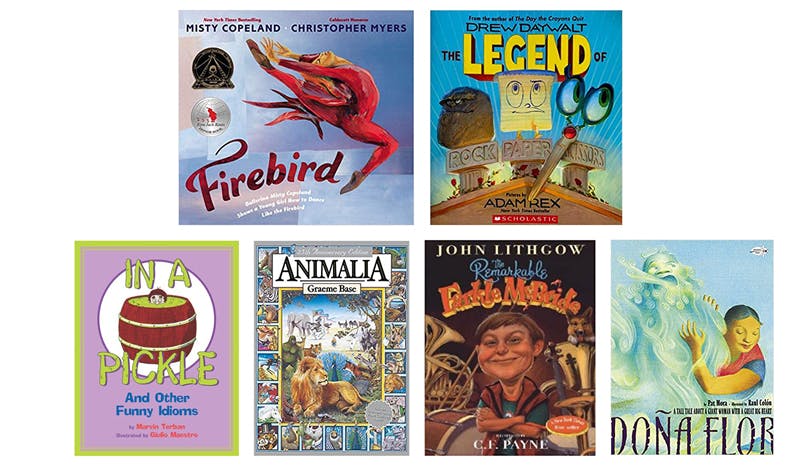
Related Figurative Language Resources
- FREE Back to School Simile and Metaphor Task Cards
- FREE Halloween Figurative Language Task Cards
- FREE Christmas Figurative Language Task Cards
- Figurative Language Flip Book
- Figurative Language Bundle
Math Picture Books
These titles help reinforce math concepts and introduce your students to inspiring mathematicians. They’re a great way to combine literacy and math skills!
Math Concepts
- Perimeter and Area: Spaghetti and Meatballs for All
- Adding and Subtracting Decimals: Pigs Will Be Pigs
- Problem Solving: The Grapes of Math
- Problem Solving: Mathterpieces
- Division: The Doorbell Rang
Inspiring Mathematicians
- The Boy Who Loved Math
- Nothing Stopped Sophie
- The Girl With a Mind for Math
- I’m Trying to Love Math
- Counting on Katherine
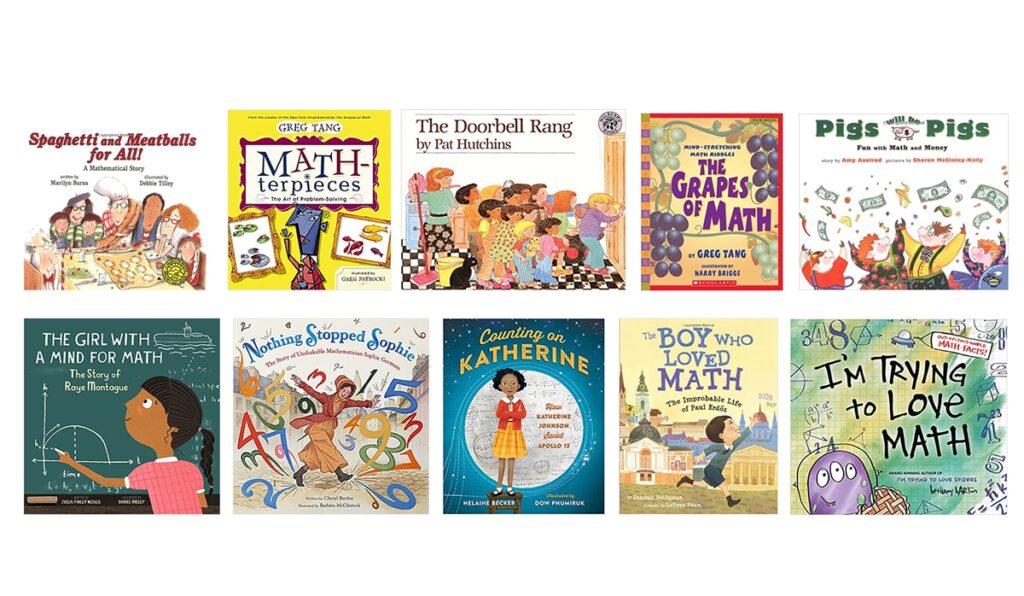
Related Math Resources
- FREE Math About Me Task Cards
- Seasonal Math Projects Bundle
- 3rd Grade Math Skill of the Day
- 4th Grade Math Skill of the Day
- 5th Grade Math Skill of the Day
Fluency Picture Books
These books are hand-selected to improve your students’ fluency. Fluency is such a crucial skill because the faster and more accurately students can read and decode, the more effectively they can comprehend.
- Good Boy, Fergus
- Help! We Need a Title! (Great for punctuation!)
- You Read to Me, I’ll Read to You
- Very Short Fairy Tales to Read Together
- Very Short Tall Tales to Read Together
- Very Short Fables to Read Together
- Very Short Scary Tales to Read Together
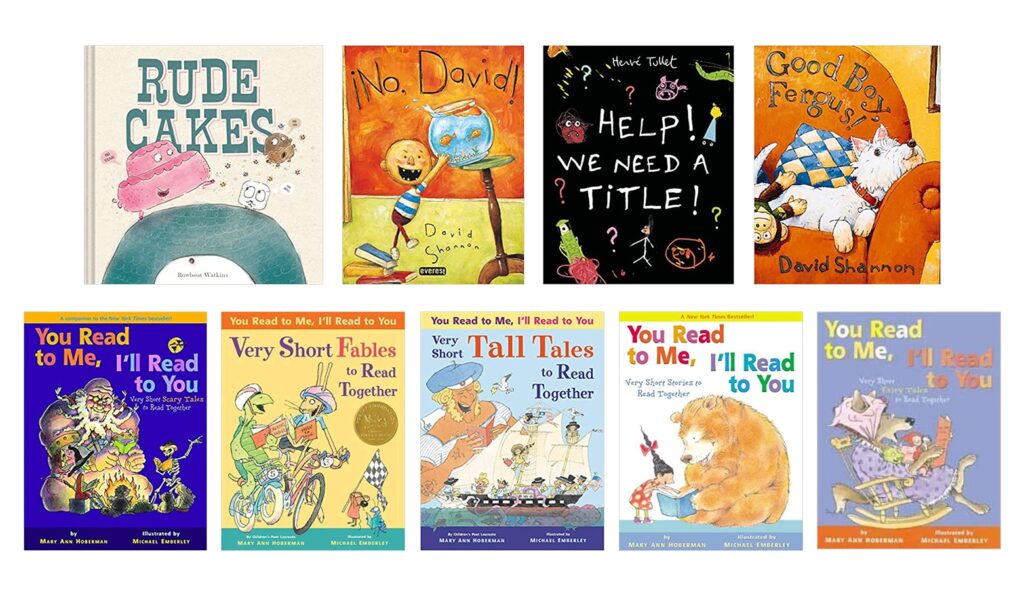
Related Fluency Resources
- FREE Fluency Starter Kit (goes with 10 fluency tips here )
- Fluency Task Cards SKILL Bundle
- Fluency Task Cards SEASONAL Bundle
Growth Mindset Picture Books
These books will help your students develop a growth mindset, which has truly become a staple life skill in our classroom
- What the Road Said
- What Do You Do with a Problem?
- Rosie Revere, Engineer
- Jabari Jumps
- The Book of Mistakes
- A Splash of Red
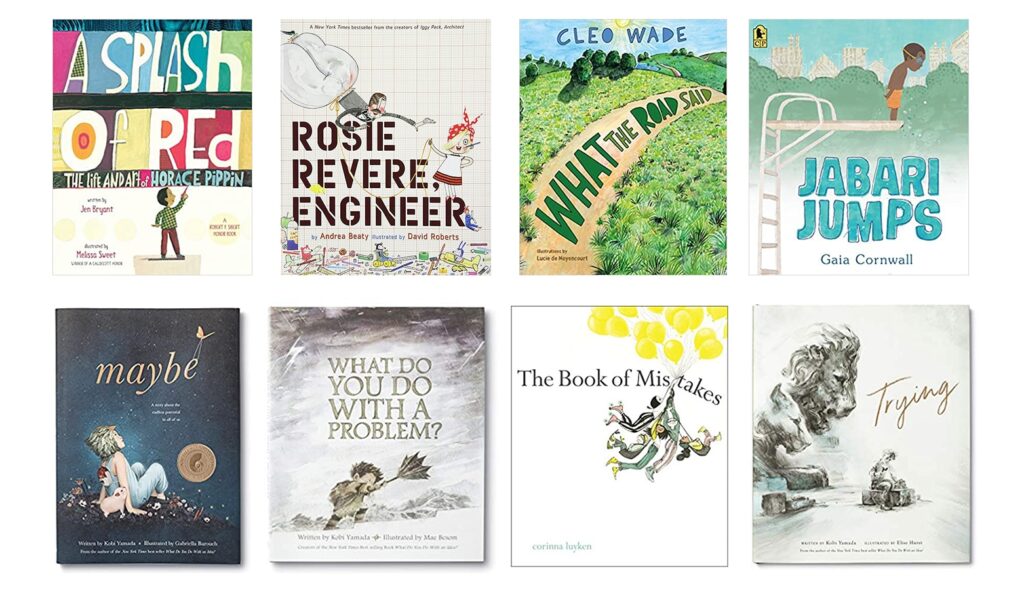
Related Growth Mindset Resources
- Creative Critical Thinking Weekly Journal
- Growth Mindset Journal
Character Building Lessons
We have created the perfect set of picture book companions to help students learn critical character and personal development skills and build classroom community. These book companions include EVERYTHING you need to implement these lessons. Just grab a copy of the book (you can also find fun read-aloud versions on YouTube), and you’ll be set to go!
Each week includes multiple lessons and activities. Depending on your classroom setup and the amount of time you have to devote to each book’s lessons, you may pick and choose which ones work best for you and your students. While the weekly activities are different to accompany each book, some consistent components include Peaks and Pits Scenario Cards, Morning Meeting Greeting Suggestions, Extension Activities, and Companion Book Suggestions.
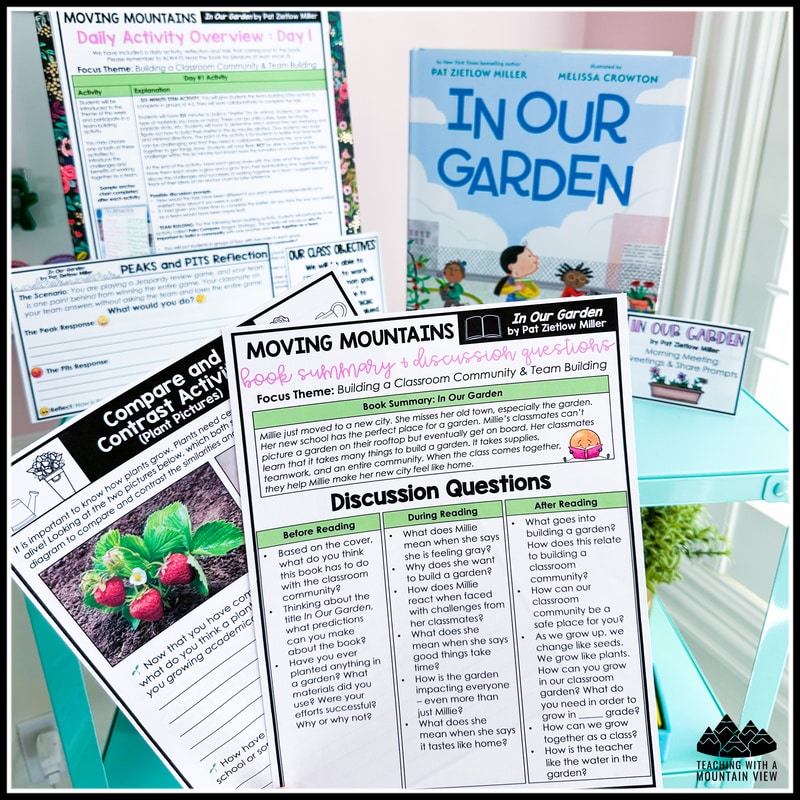
More Picture Book Resources
I also have this post on using picture books to support learning . It includes a FREE printable resource for parents!
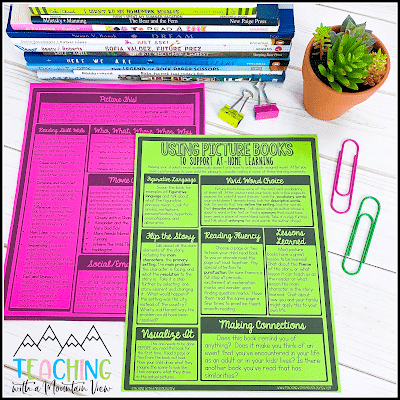
Mary Montero
I’m so glad you are here. I’m a current gifted and talented teacher in a small town in Colorado, and I’ve been in education since 2009. My passion (other than my family and cookies) is for making teachers’ lives easier and classrooms more engaging.
You might also like…

Leave a Reply Cancel reply
Your email address will not be published. Required fields are marked *
One Comment
- Pingback: How I Organize My Literacy Block - Teaching with a Mountain View

©2023 Teaching With a Mountain View . All Rights Reserved | Designed by Ashley Hughes
Username or Email Address
Remember Me
Lost your password?
Review Cart
No products in the cart.
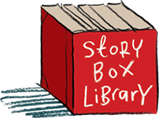
Back to all articles
Using picture books with Upper Primary students
24 Apr 2023
Educators at all levels can use picture books to engage students with important themes, especially as springboards for discussion around difficult topics. Story Box Library’s diverse and growing collection covers a broad range of topics, and our educator resources suite includes activities and printables for students to engage further with texts, themes and narratives. Watch the recommended titles below with Upper Primary students, or discover more on Story Box Library here.

First Nations’ Stories
- Come Together is a heart-warming story from pop artist Isaiah Firebrace, inspired by his petition to the Australian Government calling for Aboriginal history to be taught in every classroom. In this essential book, Isaiah, a Yorta Yorta and Gunditjmara man, establishes a foundation of First Nations knowledge with 20 key topics. Alongside bright and contemporary illustrations by Mununjali and Fijian artist Jaelyn Biumaiwai, Isaiah connects us to each topic through his own personal story and culture, from the importance of Elders to the Dreaming. Shortlisted for CBCA’s Book of the Year 2023, in the Eve Pownall category.
- Join Uncle Kuu as he takes us out on Country and explains cultural burning. For thousands of years, First Nations people have listened and responded to the land and made friends with fire, using this knowledge to encourage plants and seeds to flourish, and creating beautiful places for both animals and people to live. Watch Looking After Country With Fire: Aboriginal Burning Knowledge with Uncle Kuu.
Identity and diversity
- My Shadow is Pink is a beautifully written rhyming story that touches on the subjects of gender identity, self acceptance, equality and diversity. Inspired by the author's own little boy, 'Shadow's' main character likes princesses, fairies and things 'not for boys'... he soon learns (through the support of his dad) that everyone has a shadow that they sometimes feel they need to hide.
- Written by Jessica Saunders, Be Your Own Man and Love Your Body encourage kids to embrace and love all aspects of themselves, helping them feel more free to celebrate their unique qualities, regardless of gender.

Emotional wellbeing and resilience
- Everyone has feelings … sometimes we just don’t know what to do with them! Happy, sad, lonely, angry, anxious, proud, scared – they’re all feelings and emotions and they’re all OK! Yes – every single one of them!
- In this bright and heartening story, Josh Langley helps kids get to know and make friends with their feelings. Watch It’s Ok to Feel the Way you Do.
- How To Make A Bird is a moving and visually stunning story that celebrates the transformative power of the creative process from inception through recognition to celebration and releasing into the world.
Climate change and anxiety
- Author Jackie French and Bruce Whatley collaborated on the three books, focussed on climate change devastation, and building life back in the aftermath. Watch Flood , Drought and Fire .
- An iceberg is born into spring and travels through the seasons before dying in a new spring. A stunning, lyrical story for our times. Winner of the CBCA Picture Book of the Year 2022 and read by storyteller favourite Angourie Rice. Iceberg is available to watch now.
New story writing resource for middle & upper primary classrooms
Story Tools is a newly-launched story writing series that helps Middle and Upper Primary students (Years 3-6) master the mechanics of storytelling.
Developed to fill a gap in narrative storytelling curriculum content, featuring Australia’s most visionary and diverse children’s book creators, Story Tools is delivered via short video tutorials with accompanying resources, supporting student creativity and literacy and inspiring and creating confident storytellers. Find out more about Story Tools and try a free lesson now.

"Open ended, so versatile across year levels"
- Jackie, Primary educator
Download Story Box Library resources here, only available to active subscribers.
Top Blog Posts
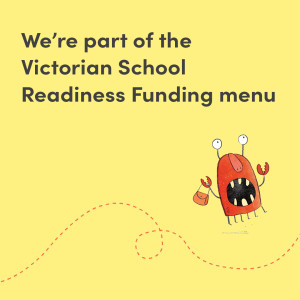
We’re part of the Victorian School Readiness Funding menu
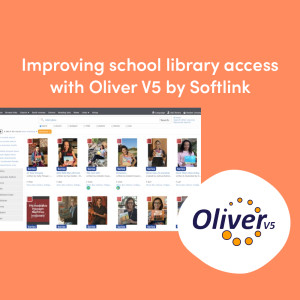
Improving school library access with Oliver V5 by Softlink
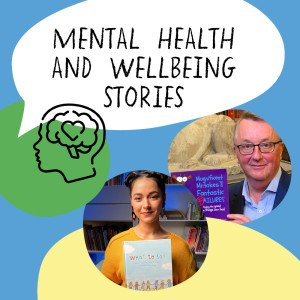
Mental health and wellbeing stories
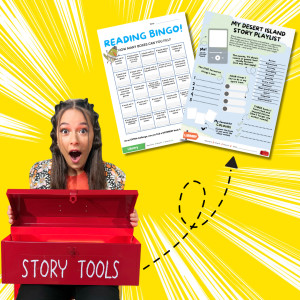
Story Tools resources now available for your Library!
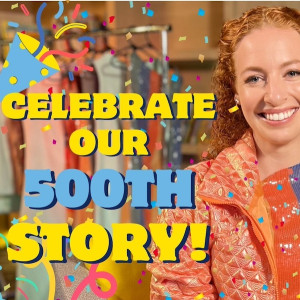
10 Years and 500 Stories - That's a Whole Lot of Fun!
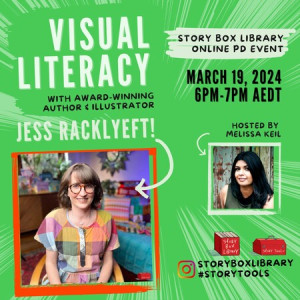
Visual Storytelling with Jess Racklyeft
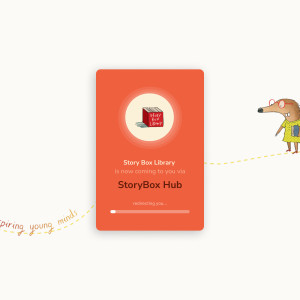
StoryBox Hub is coming... special announcement from CEO/Founder, Nicole Brownlee
- Skip to main content
- Skip to primary sidebar
- Skip to footer
Ms. Rachel Vincent
A Teaching Blog
6 Picture Books for Upper Elementary
February 18, 2021 by Rachel Vincent

Picture books for upper elementary students are perfect to use during mini-lessons to cover a variety of standards. I personally love using picture books to teach those upper elementary literacy-based standards. I also love using picture books to motivate my students to read a variety of books.
The following picture books are perfect books to do interactive read-aloud using these picture books and then we refer back to them as we are learning character development, theme, characters changing over time, story elements, and even writing personal narratives. We often compare and contrast these picture books when discussing themes, characters, etc.
The Junkyard Wonders

Better Than You

Each Kindness
Amazon Link
This is another great book for teaching theme and I really love how it doesn’t really have a “happy ending” because it leads to a great discussion.

The Other Side
This is a wonderful book to teach how setting can affect the plot of a story and how a character develops since it is a historical fiction book.

This book is perfect when talking about writing personal narratives and small moments, but also using imagery in writing.

Check out my Amazon store for some of our favorite classroom books!

msrachelvincent


- Character Traits
- Compare and Contrast
- Read Alouds
- Point of View
- Reading Response Ideas
- Summarizing
- Text Features
- Text Structures
- Find the Fib
- Reusable Ideas
- Disclosure Policy
- Lifetime Access
- 9 Low Prep Ideas
- Opinion Writing Prompts
- Student Gift Ideas
- Writing Ideas
- Party Ideas
- Countdown Ideas
The Best Read Alouds and Books for Upper Elementary
Teachers love children's books! We love to inspire a love of reading in our 3rd grade, 4th grade, and 5th grade students. It can be hard to sort through all of the options to choose the best books, however. Libraries and bookstores are full of eye catching children's options, and more are being added daily!
Check out the book recommendations for different book categories below. Some of the books are my personal favorites, while others are book recommendations from a variety of teachers that love reading to their students!
Find book recommendations for:
- the best fiction chapter book read alouds
- the best nonfiction book series
- nonfiction books for students that love animals
- wordless books for the upper elementary classroom
- fiction books for teaching point of view
- black history month biographies for upper elementary
- authors of color that will help bring diversity to your classroom library
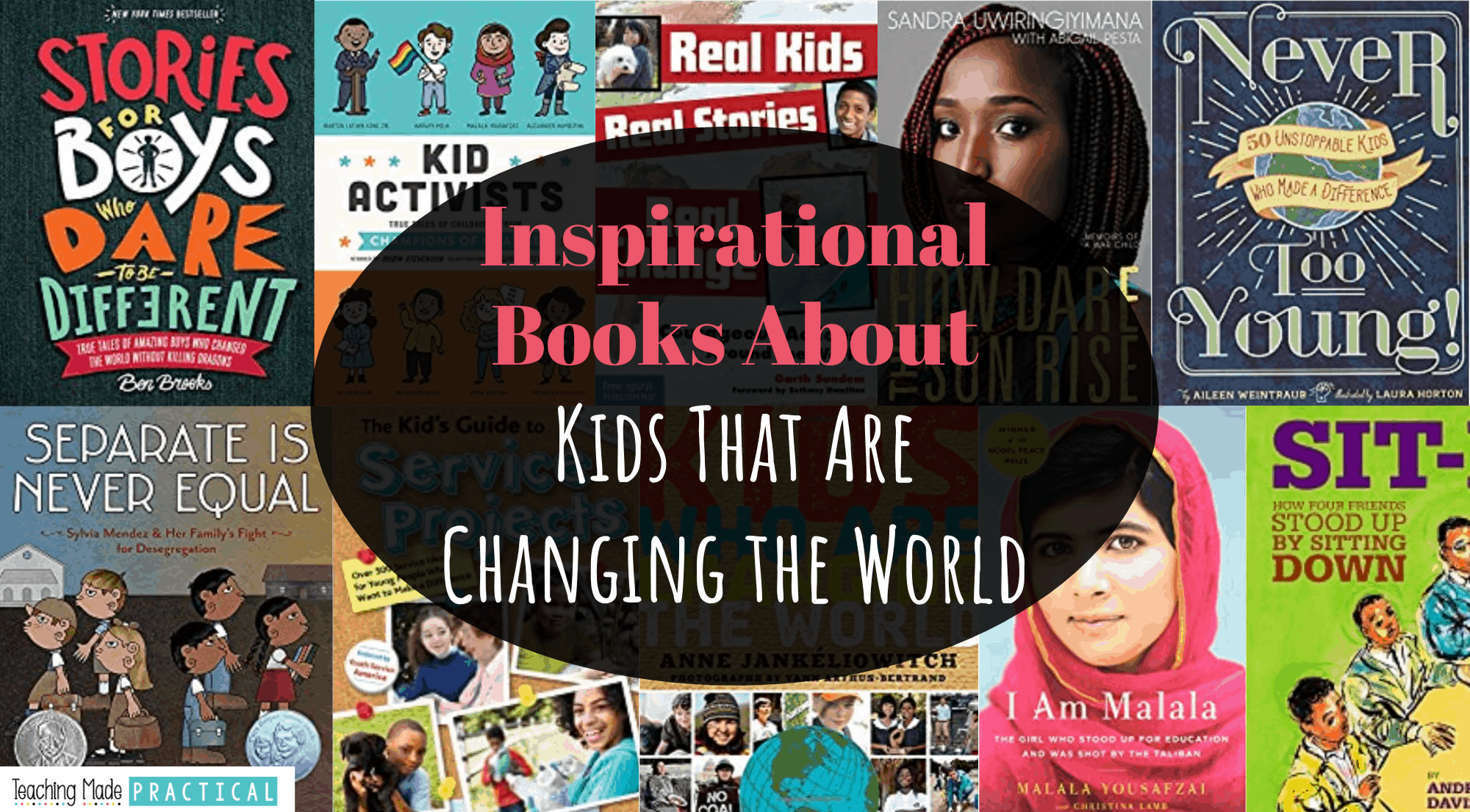
These books about kids who are changing the world are sure to inspire even your most reluctant reader in 3rd, 4th, or 5th grade!

Help create a positive classroom culture with these 10 picture books that teach kindness and empathy for upper elementary students.
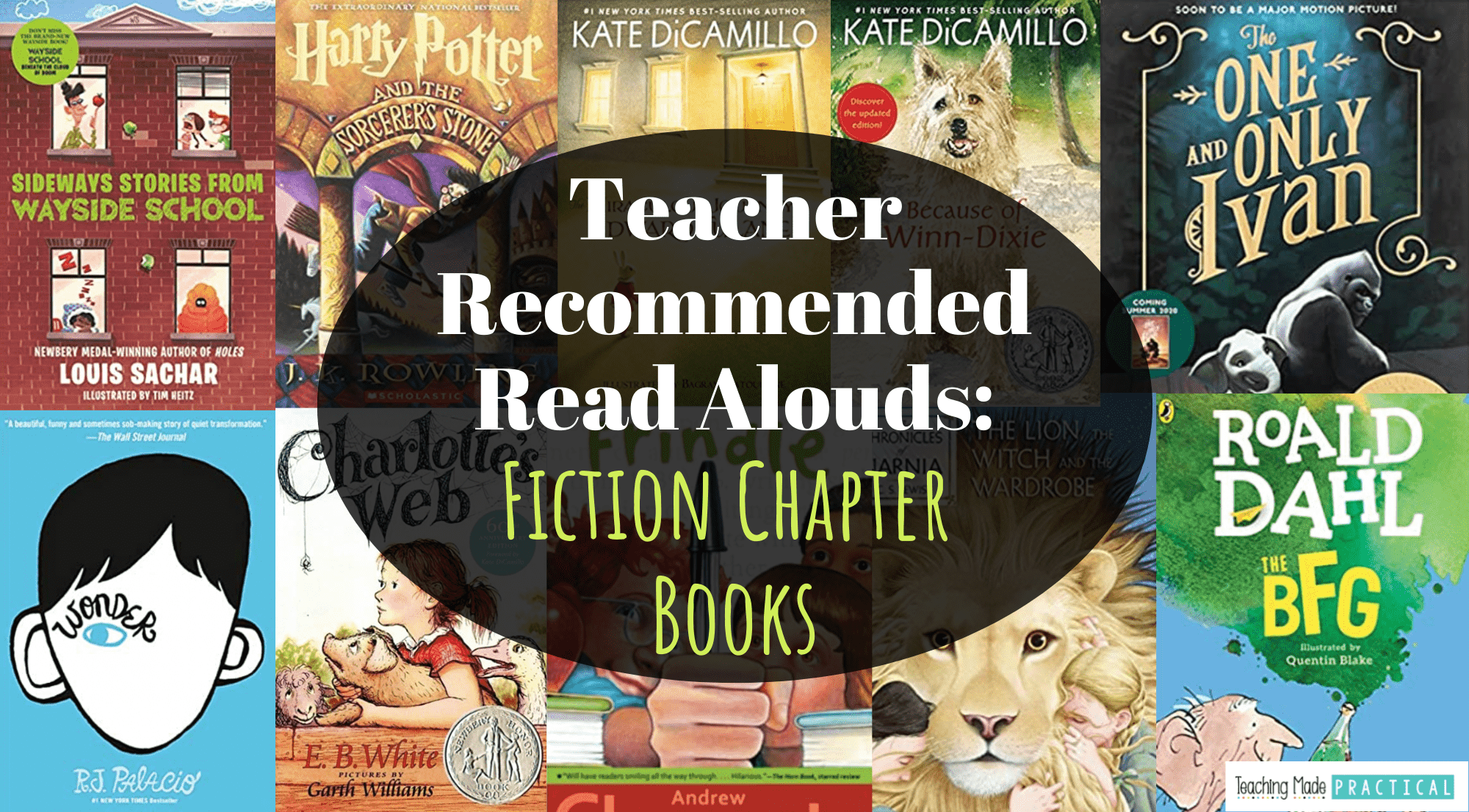
These books are great for students that hate to read but love animals! Get your upper elementary students excited about reading nonfiction books. Find my favorite nonfiction animal books here.
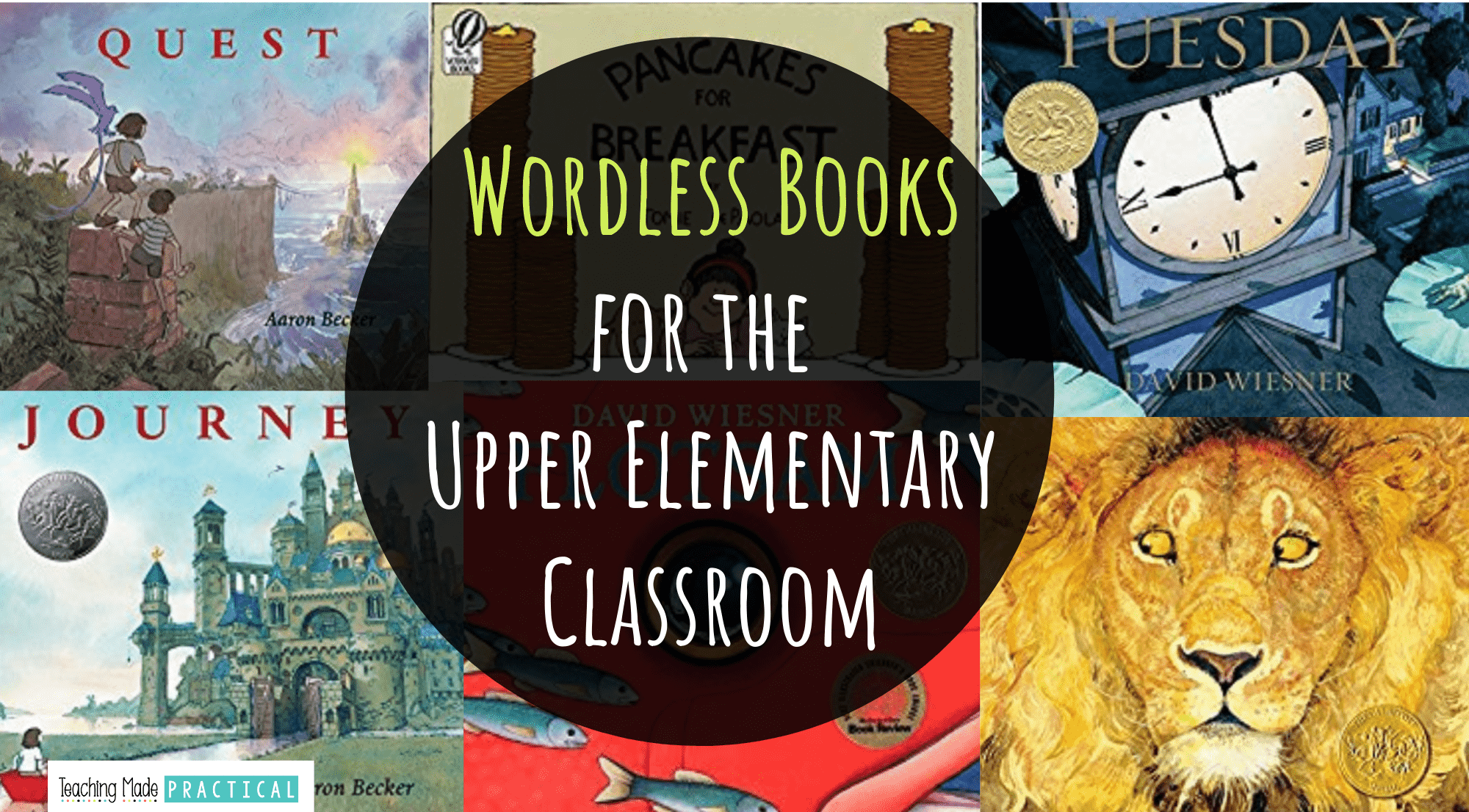
Wordless books aren't just for preschoolers. They can be a fun and engaging way to teach a variety of reading skills to 3rd grade, 4th grade, and 5th grade students. Find my wordless book recommendations here.
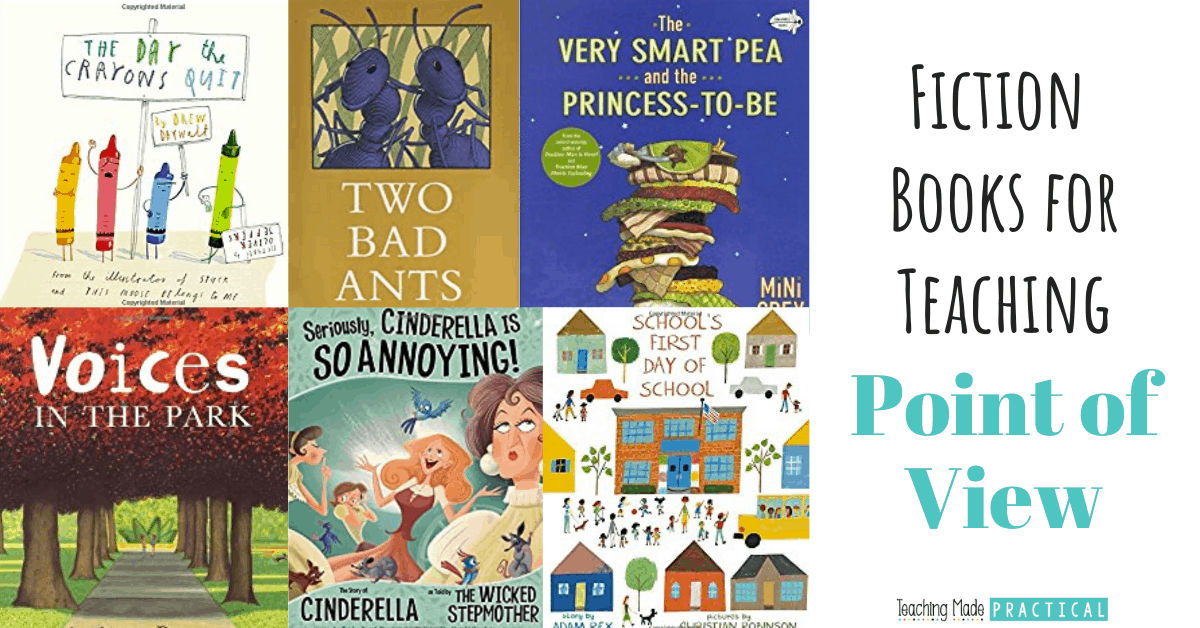
These fiction books make teaching point of view fun and engaging for your upper elementary students!
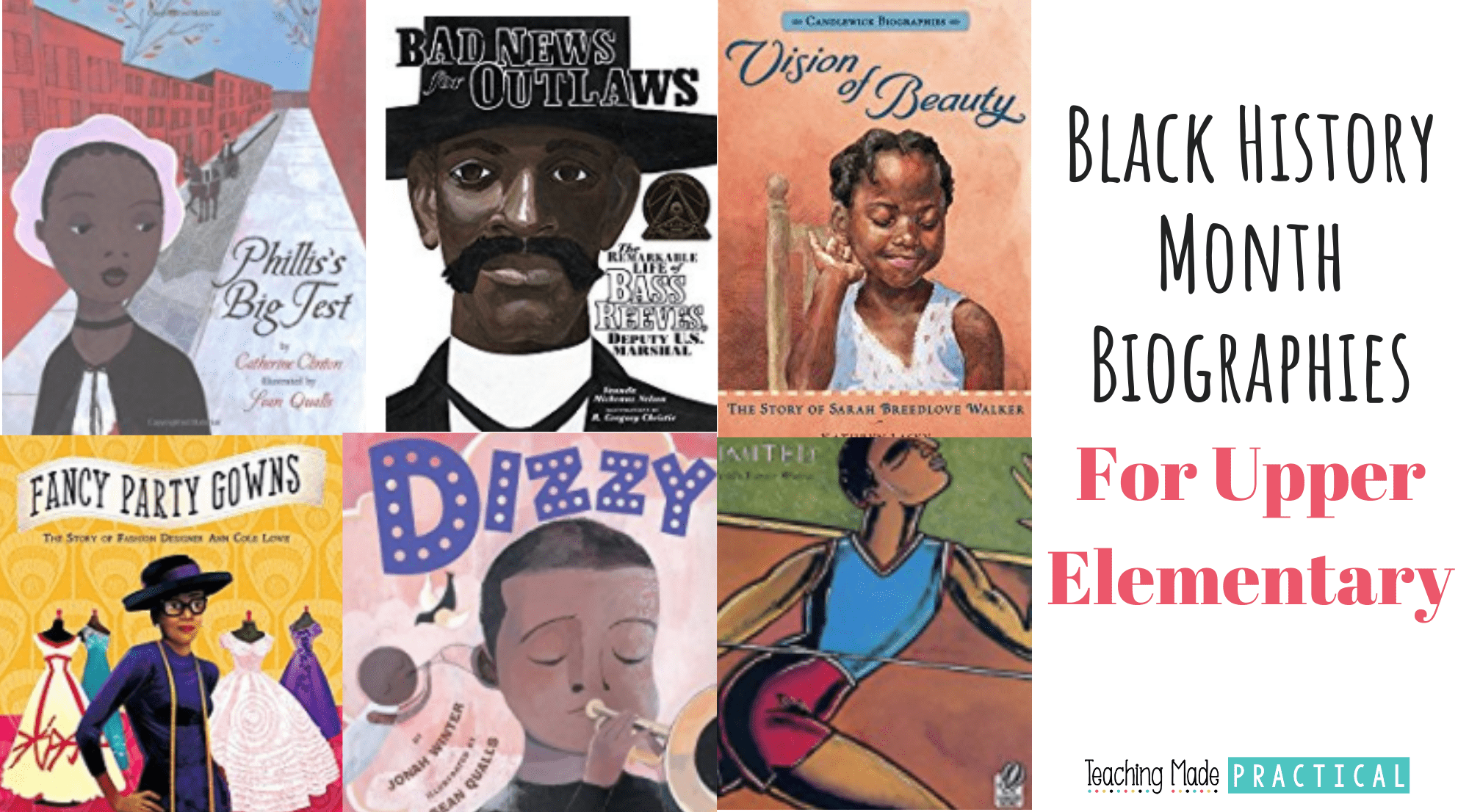
These biographies of inspiring African American are great to use all year long. Or, use them for black history month. Find my favorite black history month biographies here.
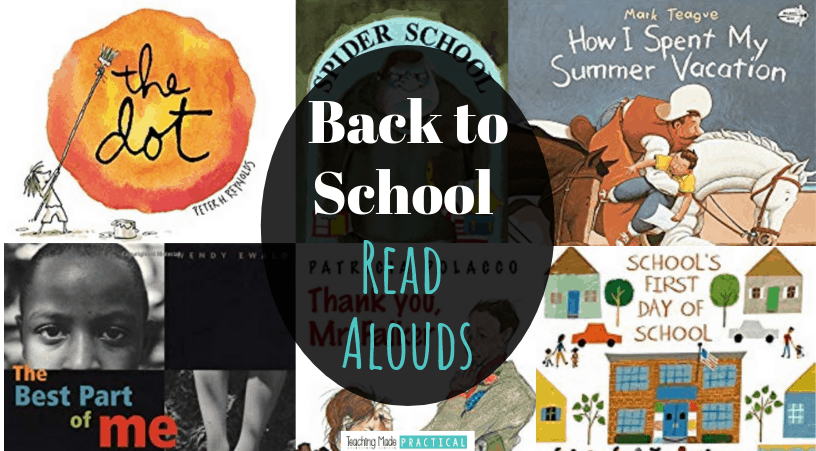
These nonfiction picture books will help your 3rd, 4th, and 5th grade students learn to love reading informational text.
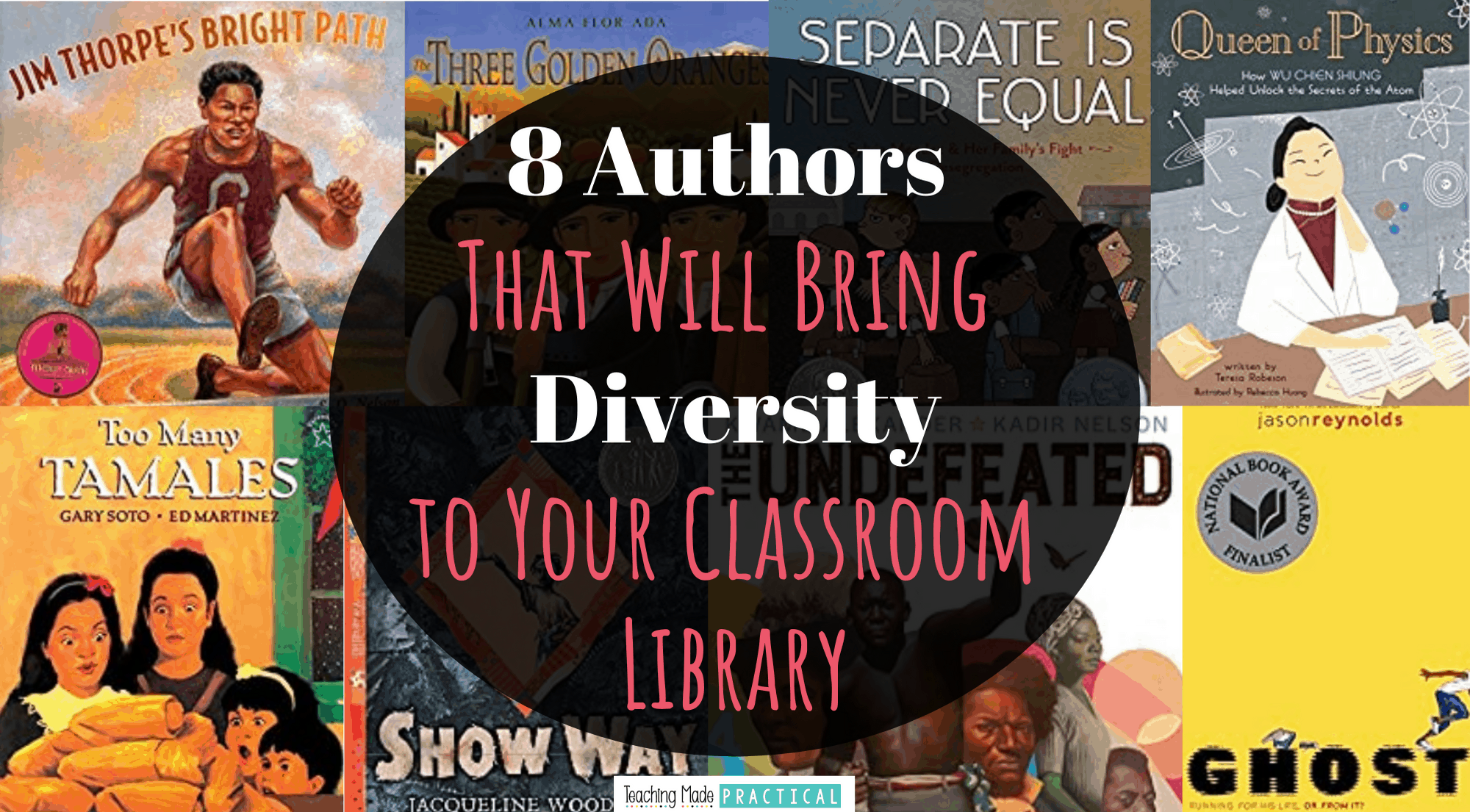
If you have students that loved Harry Potter and are looking for new books to read , then check out these recommendations.
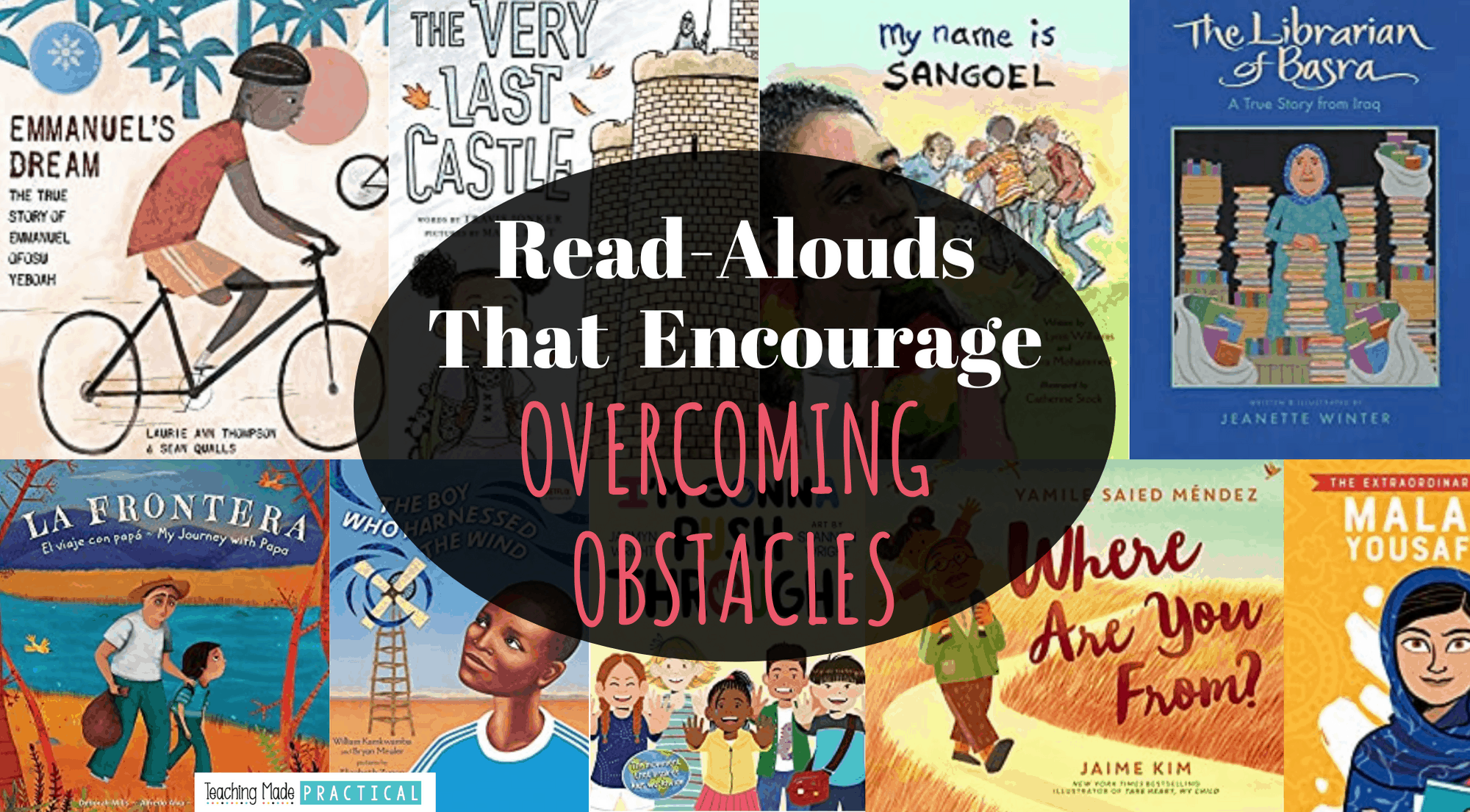
Help your third, fourth, and fifth grade students be inspired to persevere with these read alouds that encourage overcoming obstacles.
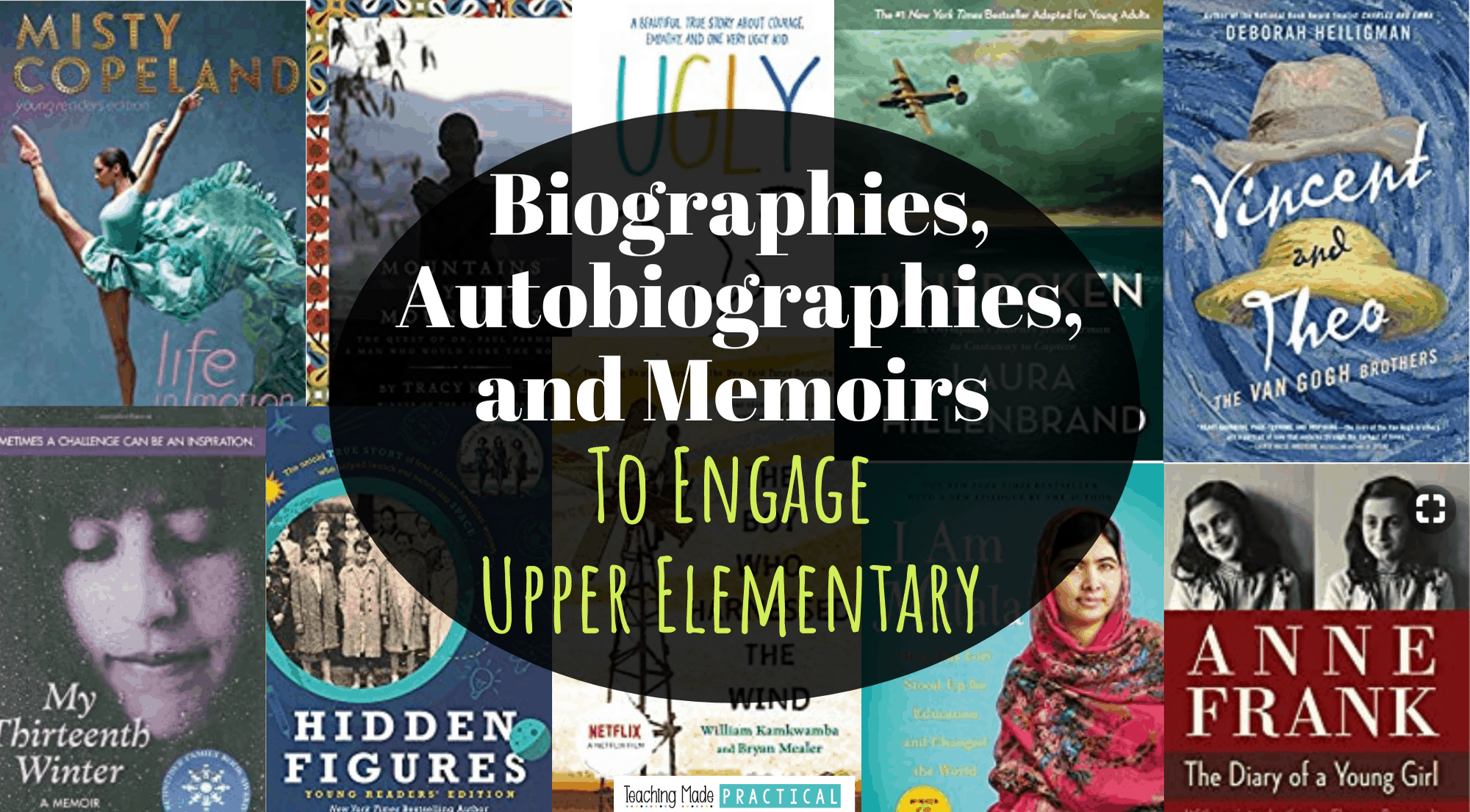
These biographies of U.S. Presidents will engage and enthrall 3rd, 4th, and 5th graders. Maybe one of your own students will be inspired to become president one day!
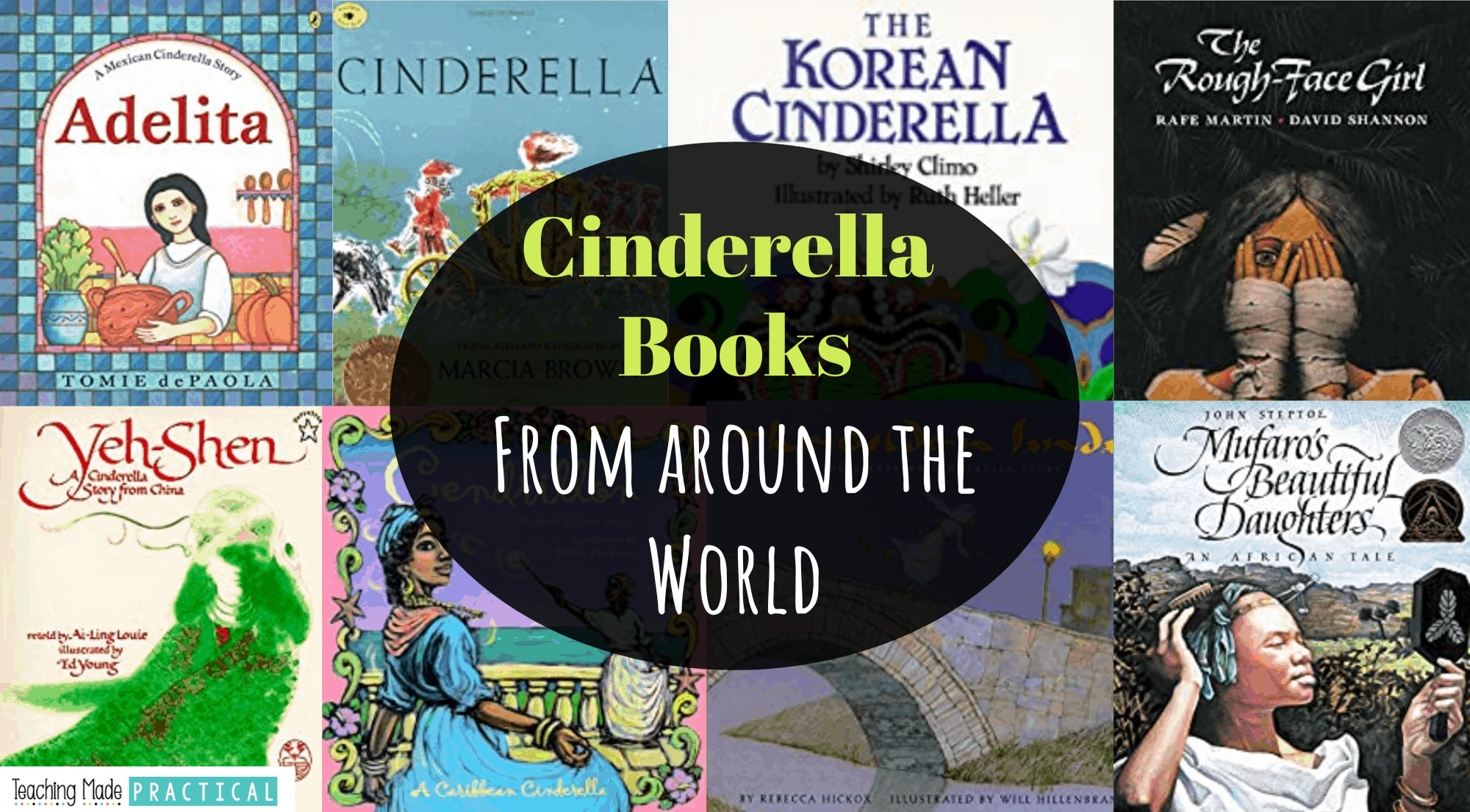
These monster books make great read alouds for 3rd, 4th, and 5th grade students around Halloween! There are fiction book recommendations, and a nonfiction book about the Loch Ness monster. 🙂
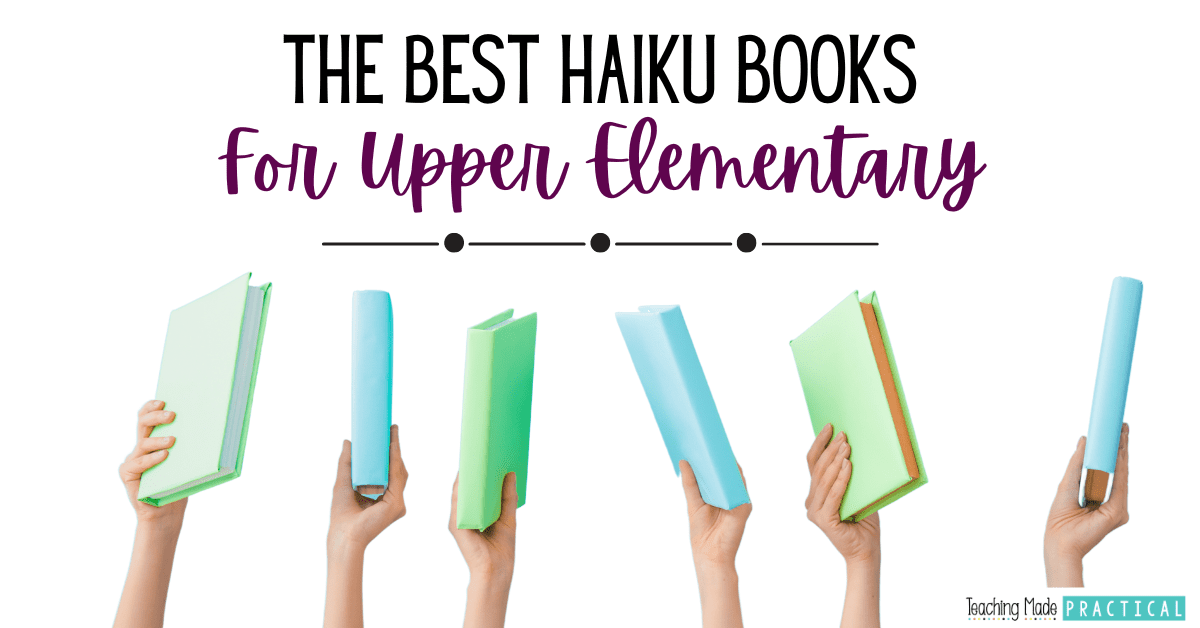
Introduce your 3rd, 4th, and 5th grade students to poetry with these haiku books. There are books with funny poems, classic poems, nature poems, and more to draw in any reader.
These book recommendations are geared towards third grade, fourth grade, and fifth grade students.
You might also like these tips and ideas for keeping your classroom library organized.
Never Stress Over Sub Plans Again!

Make copies, find a fiction book, and you'll be ready for any emergency that comes your way!
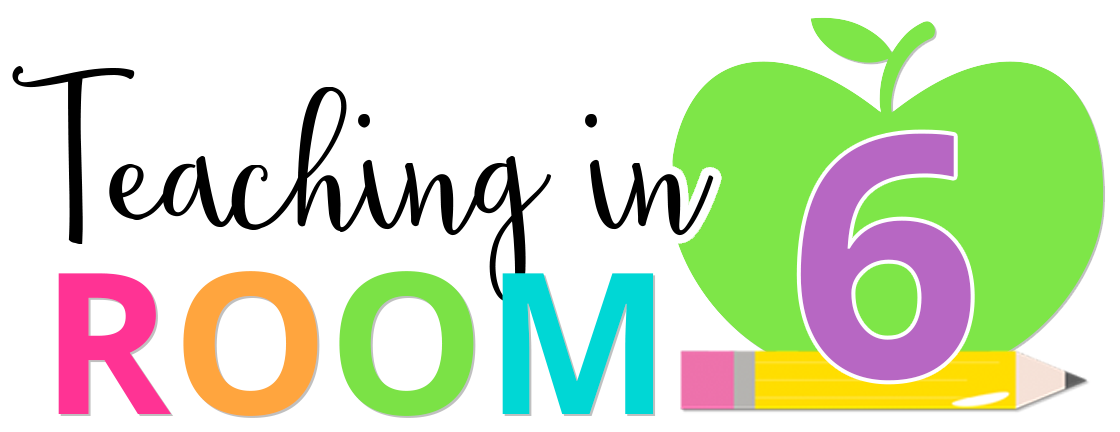
MUST HAVE Picture Books for the Upper Grades
What a great list of books! I’ve only heard of a couple of them. I’ll be off to the library this week to do some reading! Thanks for sharing.

Thank you for reading :) You are going to love these books!
You do the most AMAZING things in your classroom!! How did you make the colonies that large? I have been trying to do this, but I can't figure out how. Please help. Thank you SO much in advance.
Thanks for this list! I was especially happy to find "Separate Is Never Equal". I used "The Princess and the Warrior" by Tonatiuh last year with my students, but didn't know about his other work. I'll be using it as a Civil Rights piece the week before the MLK holiday.
Thank you! I am signed up to read to my daughter's third grade class and was looking for some inspiration!!
Please leave a comment! I love to hear what you think about what is posted :)
Welcome to Room 6!
I am so glad to have you along with me for this teaching journey we are both on.
This newsletter will always be full of tried and true, classroom tested ideas that will
work for YOU! Let's learn and grow together.
- Skip to main content
- Skip to primary sidebar
Whohoo! The new SHOP is open! Click HERE to shop now! 🛒
- NEW – All About Word Mapping!
- Shop My Site
- Search this website
A Teachable Teacher
An inspirational and resourceful website for primary teachers.
The Ultimate List of Picture Book Read Alouds for Primary Teachers
This is the ULTIMATE list of picture book read alouds for primary grades. Every topic and season is included, and books were carefully picked by teachers!
You may or may not know – but I am obsessed with teaching kids how to read! 😉
However, teaching kids to read isn’t just about phonics and fluency. It’s about fostering a love of reading. 🥰
One of my favorite way to do this is through picture book read alouds!
My teacher friends and I have spent hours and hours (teaching and) researching the very best read aloud books for primary teachers.
…and guess what? Now you don’t have to! 👏
Picking the Best Read Alouds
Trust me, this isn’t your middle-of-the-road I-can-search-Amazon list of books blog post. 😉
These books have been read and loved by primary teachers just like you. 😍 Careful attention and consideration has gone into each and every book selection.
You’ll notice we give a detailed description of each book, too. We want you to know exactly what it’s about and exactly why we love it for the classroom. 📚
Whether you’re starting your very first classroom library, or you’re looking to add to your current library, you just can’t go wrong with any of these books. 🤩
We’ve organized the best read aloud book list according to seasons, holidays, and topics! Just click on an image to see our blog post for top picture book recommendations for classroom read alouds.
Be sure to bookmark this page! We will update this book as we create quality book lists to share with you!
Back to School Read Alouds
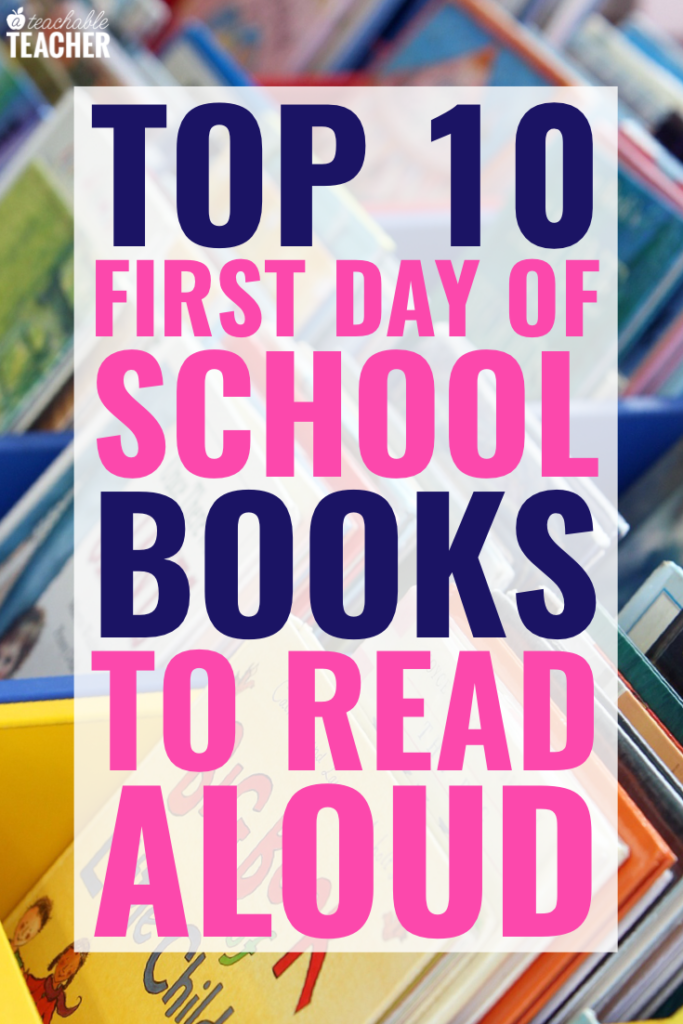
Holiday Read Alouds
February 29th coming in 2020.
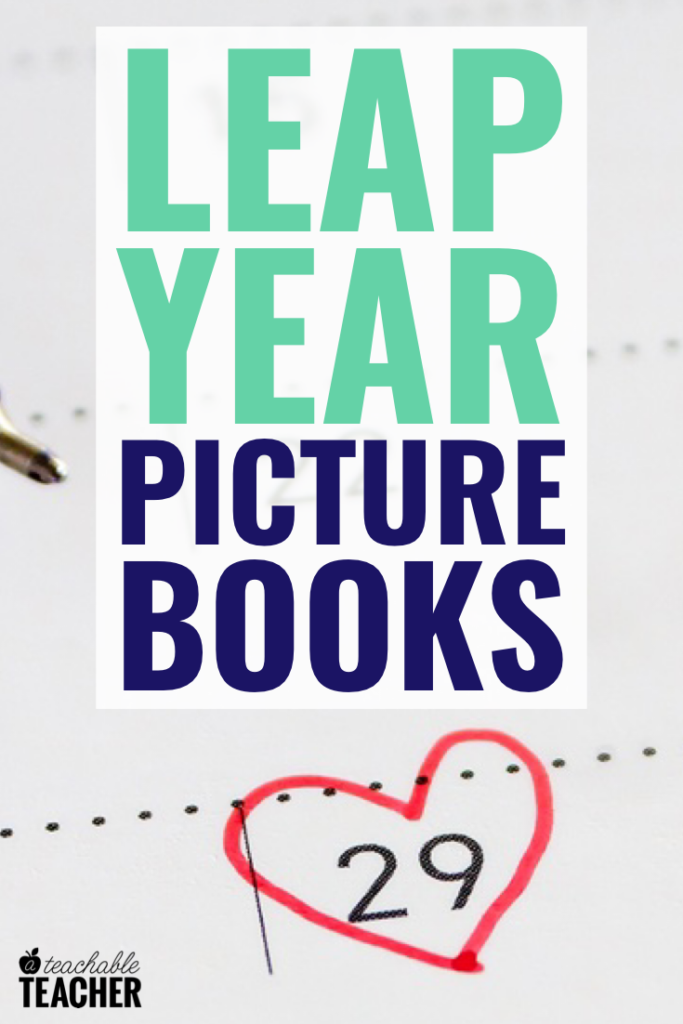
Patriot Day, September 11
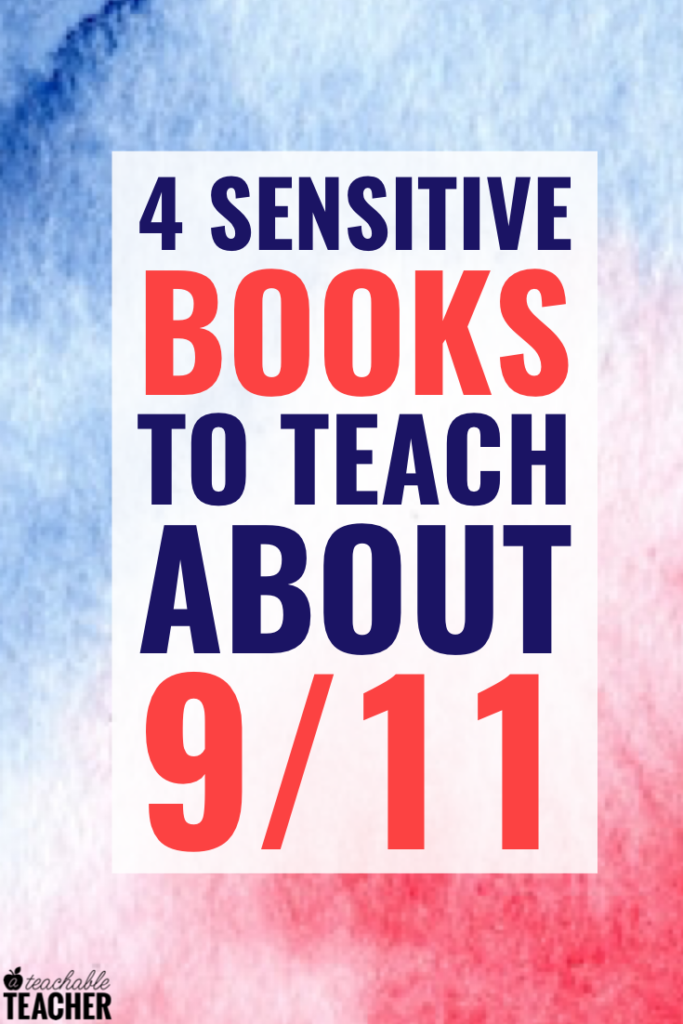

Read Alouds for Primary Grade Content
Rhyming books.
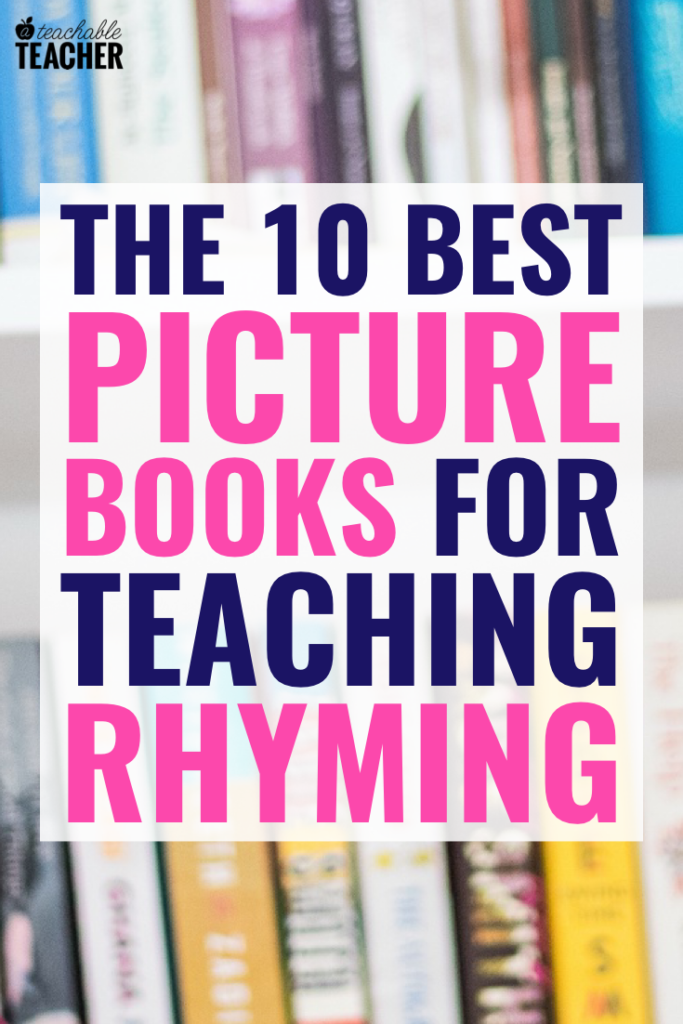
Phonemic Awareness Books
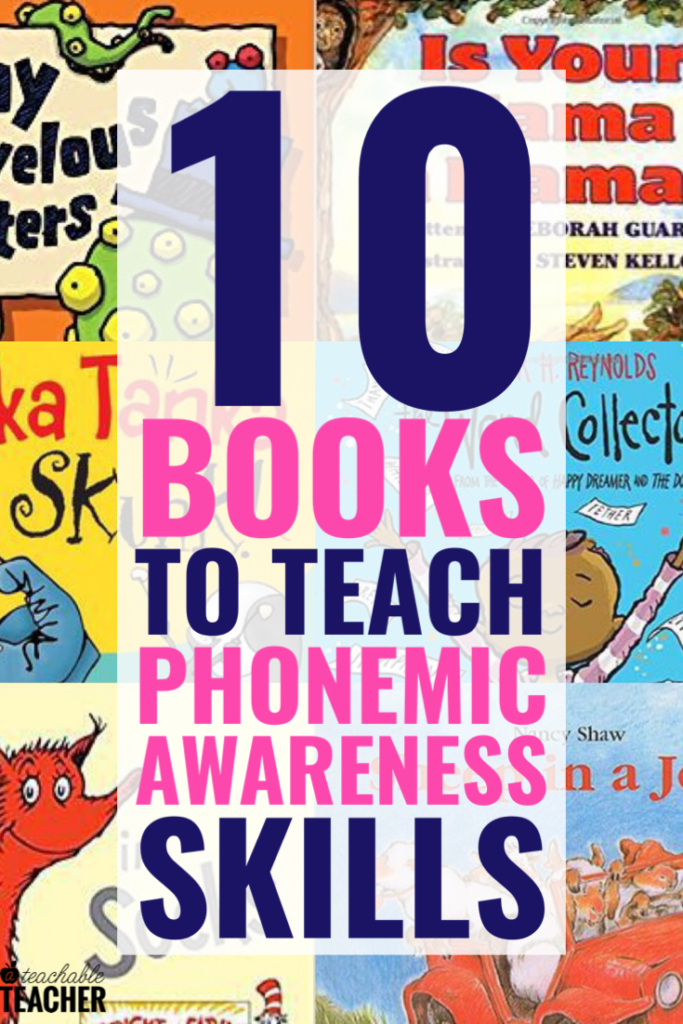
Fire Safety Books
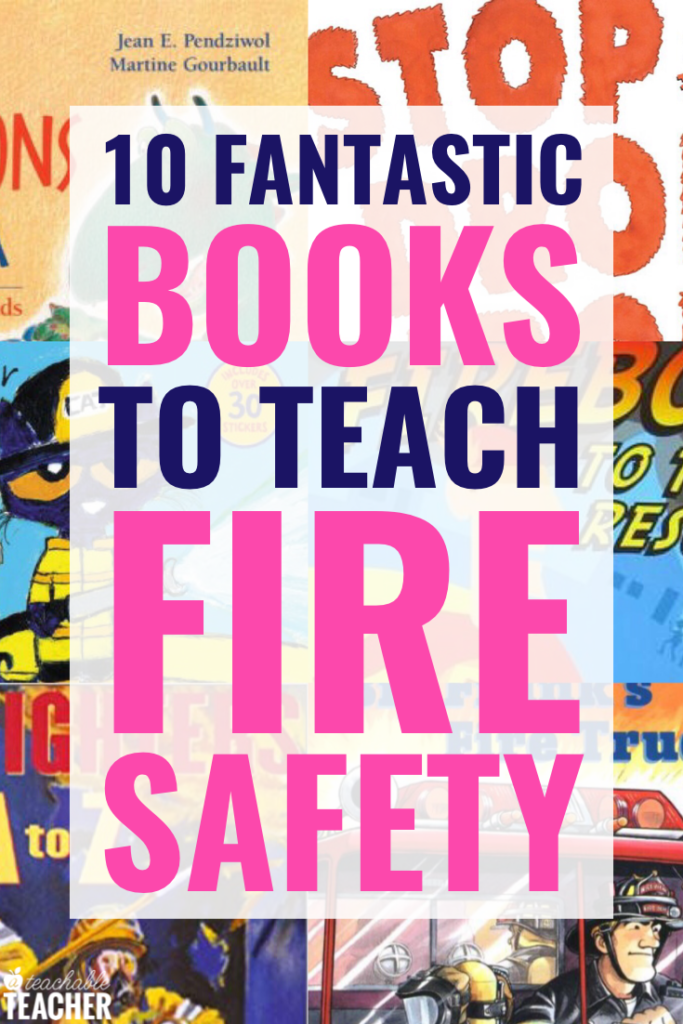
Miscellaneous Book Recommendations
My love of reading has already transferred to my baby! ? I’ve narrowed down her (and my nephew’s) favorite 11 baby books. (And that says a lot, because my husband will tell you I’ve bought them way too many books. #nevertoomany)
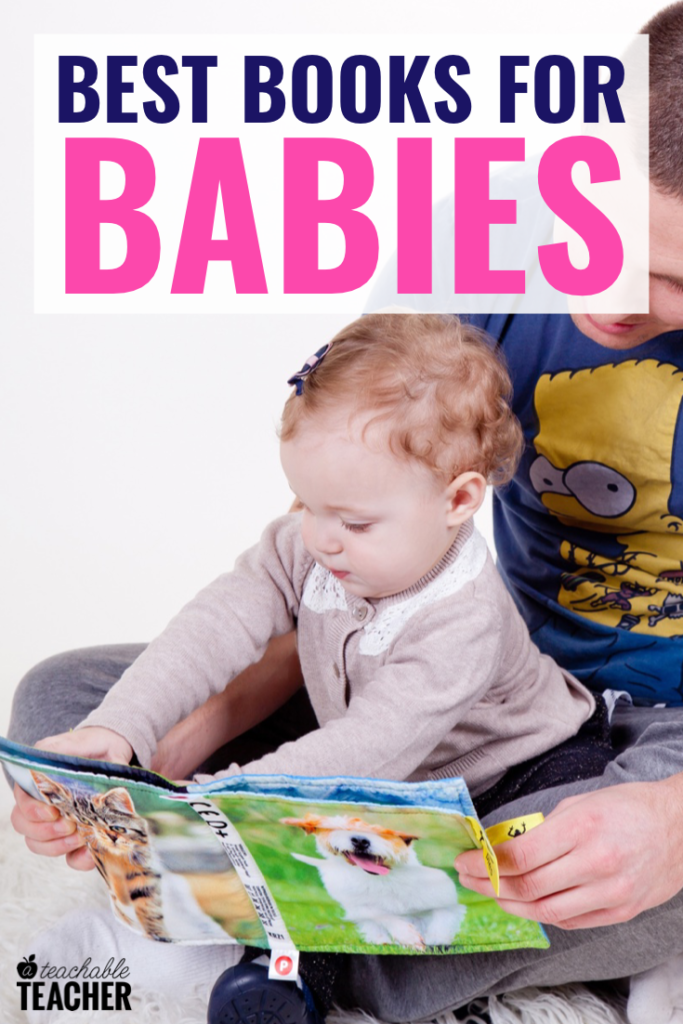
Hey, I’m Lauren!
I help elementary teachers streamline their phonics and reading instruction by giving them all of the the information and resources they need to maximize every reading lesson and raise their students’ reading levels once and for all.
- Picture Book Brain

19 New and Notable January Read Alouds for Elementary
- October 13, 2021
Looking for the best January read alouds for the classroom? These picture books for read alouds in January for elementary students are engaging for primary and upper elementary kids. Books with lesson plans and activities linked. Picture books about various topics such as winter, arctic animals, Martin Luther King Jr. Day / MLK Day and more for your kindergarten, first, second, third, fourth or fifth grade students. Your students will delight in these classic and brand new books!
If you’re a member of the Picture Book Brain Trust Community , you already have access to EVERY lesson plan and activity for these books! Just click on the Lesson Plans button in the menu!
BOOKS ABOUT WINTER
These are just a few of my favorite books to read during winter. I have a full list of my favorite winter books that you can check out.
The Wish Tree by Kyo Maclear

Charles wants to find a wish tree. His brother and sister don’t believe there is such a thing, but his trusty companion Boggan is ready to join Charles on a journey to find out. And along the way, they discover that wishes can come true in the most unexpected ways. The poetic text and heartwarming illustrations evoke the true essence of the holiday season and will inspire wishers everywhere. This gem of a book deserves center stage year round.
Get the lesson plan and activities for The Wish Tree HERE
You can try a free lesson and activities for The Wish Tree by signing up here:
Wolf In The Snow by Matthew Cordell

A girl is lost in a snowstorm . A wolf cub is lost, too. How will they find their way home? This is a great book about not judging a book by its cover which is funny because it’s a book that won a Caldecott Medal. Maybe it’s because an almost completely wordless book ?
Get the lesson plan and activities for Wolf In The Snow HERE

Snowflake Bentley by Jacqueline Briggs Martin

Wilson Bentley was always fascinated by snow. In childhood and adulthood, he saw each tiny crystal of a snowflake as a little miracle and wanted to understand them. His parents supported his curiosity and saved until they could give him his own camera and microscope. At the time, his enthusiasm was misunderstood. But with patience and determination, Wilson catalogued hundreds of snowflake photographs, gave slideshows of his findings and, when he was 66, published a book of his photos. His work became the basis for all we know about beautiful, unique snowflakes today. A really interesting biography picture book for the winter months!
Get the lesson plan and activities for Snowflake Bentley HERE
Extra Yarn by Mac Barnett

A young girl and her box of magical yarn transform a community in this stunning picture book. With spare, gently humorous illustrations and a palette that moves from black-and-white to a range of color, this modern fairy tale has the feel of a new classic. This is an amazing book about how one person can change a community completely.
Get the lesson plan and activities for Extra Yarn HERE
The Mitten by Jan Brett

When Nicki drops his white mitten in the snow, he goes on without realizing that it is missing. One by one, woodland animals find it and crawl in; first, a curious mole, then a rabbit, a badger and others, each one larger than the last. Finally, a big brown bear is followed in by a tiny brown mouse and what happens next makes for a wonderfully funny climax. As the story of the animals in the mitten unfolds, the reader can see Nicki’s snowy outing in the borders of each page. As you plan out your year of books to read aloud to your first graders, this is definitely one of the best books to read in winter !
The Shortest Day by Susan Cooper

As the sun set on the shortest day of the year, early people would gather to prepare for the long night ahead. They built fires and lit candles. They played music, bringing their own light to the darkness, while wondering if the sun would ever rise again. Written for a theatrical production that has become a ritual in itself, Susan Cooper’s poem “The Shortest Day” captures the magic behind the returning of the light, the yearning for traditions that connect us with generations that have gone before — and the hope for peace that we carry into the future. Richly illustrated by Carson Ellis with a universality that spans the centuries, this beautiful book evokes the joy and community found in the ongoing mystery of life when we celebrate light, thankfulness, and festivity at a time of rebirth. Welcome Yule!
And Tango Makes Three by Justin Richardson

The heartwarming true story of two male penguins who create a nontraditional family is now available in a sturdy board book edition.
At the penguin house at the Central Park Zoo, two penguins named Roy and Silo were a little bit different from the others. But their desire for a family was the same. And with the help of a kindly zookeeper, Roy and Silo got the chance to welcome a baby penguin of their very own. A story great for talking about having same sex parents .
Get the lesson plan and activities for And Tango Makes Three HERE
Owl Moon by Jane Yolen

Late one winter night a little girl and her father go owling. The trees stand still as statues and the world is silent as a dream. Whoo-whoo-whoo, the father calls to the mysterious nighttime bird. But there is no answer. Wordlessly the two companions walk along, for when you go owling you don’t need words. You don’t need anything but hope. Sometimes there isn’t an owl, but sometimes there is.
Get the lesson plan and activities for Owl Moon HERE
Those Shoes by Maribeth Boelts

All Jeremy wants is a pair of those shoes, the ones everyone at school seems to be wearing. Though Jeremy’s grandma says they don’t have room for “want,” just “need,” when his old shoes fall apart at school, he is more determined than ever to have those shoes, even a thrift-shop pair that are much too small. But sore feet aren’t much fun, and Jeremy soon sees that the things he has — warm boots, a loving grandma, and the chance to help a friend — are worth more than the things he wants.
Get the lesson plan and activities for Those Shoes HERE
Knut by Juliana Hatkoff

When Knut was born, the first polar bear cub at the Berlin Zoo in more than thirty years, he was no bigger than a snowball and unable to care for himself. His mother, a rescued East German circus bear, didn’t know how to take care of Knut and rejected him. Knut would have died if it weren’t for Thomas Dorflein, a zookeeper who nurtured Knut, feeding him, sleeping with him, and giving him the love and attention Knut needed to thrive. But Thomas wasn’t the only one who adopted Knut. The adorable little polar bear captured the world’s attention, and now Knut is loved around the globe. A great story for studies about arctic animals !
Get the lesson plan and activities for Knut HERE
The Great Paper Caper by Oliver Jeffers

The animals’ homes are disappearing. Tree by tree, the forest is being cut down. Clues! There must be clues. For instance, look–there is a mysterious bear carrying an ax! But what would a bear want with so many trees? Perhaps the discarded paper airplanes littering the forest floor have a story to tell? A really great book for studying the mystery genre!
Get the lesson plan and activities for The Great Paper Caper HERE
Lost and Found by Oliver Jeffers

What is a boy to do when a lost penguin shows up at his door? Find out where it comes from, of course, and return it. But the journey to the South Pole is long and difficult in the boy’s rowboat. There are storms to brave and deep, dark nights.To pass the time, the boy tells the penguin stories. Finally, they arrive. Yet instead of being happy, both are sad. That’s when the boy realizes: The penguin hadn’t been lost, it had merely been lonely.
A poignant, funny, and child-friendly story about friendship lost . . . and then found again.
Get the lesson plan and activities for Lost and Found HERE
MARTIN LUTHER KING JR. DAY
MLK Day is the third Monday of January each year. There are many excellent books to read for the holiday that can open students’ eyes to the many amazing things that this man did in his short life. Be sure to grab some of these to read this year!
Martin’s Big Words by Doreen Rappaport

Martin Luther King, Jr., was one of the most influential and gifted speakers of all time. Doreen Rappaport uses quotes from some of his most beloved speeches to tell the story of his life and his work in a simple, direct way. Bryan Collier’s stunning collage art combines remarkable watercolor paintings with vibrant patterns and textures. A timeline and a lsit of additional books and web sites help make this a standout biography of Dr. King. Definitely one of my favorite read aloud books for 3rd grade to talk about MLK and activism .
Get the lesson plan and activities for Martin’s Big Words HERE
Lillian’s Right to Vote by Jonah Winter

An elderly African American woman, en route to vote , remembers her family’s tumultuous voting history in this picture book publishing in time for the fiftieth anniversary of the Voting Rights Act of 1965.
As Lillian, a one-hundred-year-old African American woman, makes a “long haul up a steep hill” to her polling place, she sees more than trees and sky—she sees her family’s history. She sees the passage of the Fifteenth Amendment and her great-grandfather voting for the first time. She sees her parents trying to register to vote. And she sees herself marching in a protest from Selma to Montgomery. Veteran bestselling picture-book author Jonah Winter and Coretta Scott King Illustrator Award winner Shane W. Evans vividly recall America’s battle for civil rights in this lyrical, poignant account of one woman’s fierce determination to make it up the hill and make her voice heard.
Get the lesson plan and activities for Lillian’s Right to Vote HERE
The Oldest Student by Rita Lorraine Hubbard

Imagine learning to read at the age of 116! Discover the true story of Mary Walker, the nation’s oldest student who did just that, in this picture book from a Caldecott Honor-winning illustrator and a rising star author.
In 1848, Mary Walker was born into slavery. At age 15, she was freed, and by age 20, she was married and had her first child. By age 68, she had worked numerous jobs, including cooking, cleaning, babysitting, and selling sandwiches to raise money for her church. At 114, she was the last remaining member of her family. And at 116, she learned to read. From Rita Lorraine Hubbard and rising star Oge More comes the inspirational story of Mary Walker, a woman whose long life spanned from the Civil War to the Civil Rights Movement, and who–with perseverance and dedication–proved that you’re never too old to learn.
Get the lesson plan and activities for The Oldest Student HERE
So Tall Within by Gary Schmidt

Sojourner Truth was born into slavery but possessed a mind and a vision that knew no bounds. So Tall Within traces her life from her painful childhood through her remarkable emancipation to her incredible leadership in the movement for rights for both women and African Americans. Her story is told with lyricism and pathos by Gary D. Schmidt, one of the most celebrated writers for children in the twenty-first century, and brought to life by award winning and fine artist Daniel Minter. This combination of talent is just right for introducing this legendary figure to a new generation of children.
Get the lesson plan and activities for So Tall Within HERE
Pies From Nowhere by Dee Romito

Georgia Gilmore was a cook at the National Lunch Company in Montgomery, Alabama. When the bus boycotts broke out in Montgomery after Rosa Parks was arrested, Georgia knew just what to do. She organized a group of women who cooked and baked to fund-raise for gas and cars to help sustain the boycott. Called the Club from Nowhere, Georgia was the only person who knew who baked and bought the food, and she said the money came from “nowhere” to anyone who asked.
When Martin Luther King Jr. was arrested for his role in the boycott, Georgia testified on his behalf, and her home became a meeting place for civil rights leaders . This picture book highlights a hidden figure of the civil rights movement who fueled the bus boycotts and demonstrated that one person can make a real change in her community and beyond. It also includes one of her delicious recipes for kids to try with the help of their parents!
Get the lesson plan and activities for Pies From Nowhere HERE
Rosa by Nikki Giovanni

Fifty years after her refusal to give up her seat on a Montgomery, Alabama, city bus, Mrs. Rosa Parks is still one of the most important figures in the American civil rights movement. This tribute to Mrs. Parks is a celebration of her courageous action and the events that followed.
Get the lesson plan and activities for Rosa HERE
Overground Railroad by Lesa Cline-Ransome

A window into a child’s experience of the Great Migration from the award-winning creators of Before She Was Harriet and Finding Langston.
Climbing aboard the New York bound Silver Meteor train, Ruth Ellen embarks upon a journey toward a new life up North– one she can’t begin to imagine. Stop by stop, the perceptive young narrator tells her journey in poems, leaving behind the cotton fields and distant Blue Ridge mountains.
Each leg of the trip brings new revelations as scenes out the window of folks working in fields give way to the Delaware River, the curtain that separates the colored car is removed, and glimpses of the freedom and opportunity the family hopes to find come into view. As they travel, Ruth Ellen reads from Narrative of the Life of Frederick Douglass, reflecting on how her journey mirrors her own– until finally the train arrives at its last stop, New York’s Penn Station, and the family heads out into a night filled with bright lights, glimmering stars, and new possiblity.
Get the lesson plan and activities for Overground Railroad HERE
Best January Read Alouds
What are some of your favorite January read alouds? Are there any must read January read alouds that I left out? Let me know in the comments, and I’ll add it!
Remember : You can try a free lesson and activities for The Wish Tree by signing up here:

Share with a Colleague:
Other posts you might like:.

Chester Nez and the Unbreakable Code Resources

Voices in the Park Resources

The Curious Garden Resources

Hey there! I’m Josh from Picture Book Brain here to share only the best literature for you to use with your students. If you are looking for a specific book, use the search bar below to check my archives. Glad you’re here, and glad to help you!
find what you need
Become a member.

find books you need

Get free training

Have a question?

membership info

2024 Planners Available Now!

Item added to your cart
Unlocking minds: the power of picture books for upper primary students.
Picture books are often associated with early childhood education, but their magic extends far beyond those years. In fact, incorporating picture books into upper primary classrooms can have a profound impact on students' learning, imagination, and cognitive development. Let's dive into why it's crucial to continue exploring the world of picture books with older students.
1. Igniting Imagination: Picture books are gateways to endless imagination. They transport readers to vivid worlds, sparking creativity and curiosity. For upper primary students, these visual narratives provide a fresh canvas for their minds to roam freely, encouraging them to visualise stories in unique ways.
2. Fostering Critical Thinking: The layers within picture books offer rich fodder for critical thinking. Upper primary students can analyse complex themes, interpret symbolism, and explore characters' motivations. Delving into deeper discussions about the nuances of a story helps students develop essential analytical skills.
3. Expanding Vocabulary and Language Skills: Picture books are treasure troves of diverse vocabulary. Exposing upper primary students to a wide range of words and phrases through visually engaging stories enhances their language skills. This expanded vocabulary then reflects in their reading, writing, and communication abilities.
4. Encouraging Empathy and Emotional Intelligence: Picture books often tackle profound emotions and real-life scenarios. Upper primary students can connect deeply with characters' experiences, fostering empathy and emotional intelligence. Through these stories, they learn to appreciate diverse perspectives and develop a greater understanding of the world around them.
5. Cultivating a Love for Reading: As students grow older, the pressures of academics and screen time can sometimes overshadow the joy of reading. Picture books act as bridges to reignite that passion. Their visually appealing format and engaging stories reignite the joy of reading and create positive reading experiences.
6. Inspiring Thought-Provoking Discussions: Picture books hold within them themes that resonate with all age groups. In upper primary classrooms, these themes can fuel captivating discussions about ethics, society, and personal growth. Engaging in thoughtful conversations about these topics encourages students to develop their own opinions and learn from their peers.
7. Building Visual Literacy: In today's visual world, being able to interpret and analyse visual information is a valuable skill. Picture books provide opportunities for students to practice visual literacy, decoding imagery alongside text. This skill translates beyond literature into understanding infographics, advertisements, and media.
Incorporating picture books into upper primary education bridges the gap between visual appeal and intellectual growth. Their ability to captivate, challenge, and inspire makes them an invaluable tool in fostering a love for learning in students of all ages. By recognizing and embracing the magic of picture books, educators can open doors to boundless exploration and imagination for their upper primary students.
What are your favourite picture books to use with your upper primary students?
Leave a comment
Please note, comments need to be approved before they are published.
- Choosing a selection results in a full page refresh.
- Opens in a new window.
Let customers speak for us
So sleek! So well set out. Strong cover! 💪
Hi, our Riebe planners arrived- we love them. How bright they are. I really like that they are divided into Terms and also have the term planner at the beginning of each term. I would love to see a plastic or bigger cardboard holder extra papers on the inside of the front cover and one of our teachers cleverly added a ribbon to know the day so I would include a matching ribbon for the page bookmark. Really good qulaity and for me each day has enough room.
Reibe Planners has done it again! Jodie and Linda are amazing and have come up with a beautiful and unique decor for the classroom. So many wonderful options to choose from and use. It has brought brightness to my classroom. Thank you ladies!

2024 Kaleidoscope Teacher Planner - Weekly
Really good quality and extremely practical with loads of room for planning, assessment and additional notes. My second time purchasing.
my journey into the world of librarianship

Sophisticated Picturebooks in Upper Primary Classrooms
This article identifies the benefits of using sophisticated picturebooks in the instruction of key stage 2 students (years 4 to 6). The author looks at the genre definition, features, value and pedagogical use of picturebooks aimed at older students and in particular the benefits of their use that go beyond literacy development. Furthermore, the article focuses on the role of the Teacher Librarian (TL) in developing the sub-genre in the library collection, the range of possibilities its use offers for teaching and learning, and its promotion with upper primary students and teachers.
Introduction
There is a tendency amongst teachers and parents to move able readers away from picturebooks and “upwards” into reading chapter books as early as possible. This tendency, felt acutely by the students themselves, throws an unjust judgement of all picturebooks as being simple and suited for a young and less able audience. There is, however, a whole sub-genre that has emerged within picturebooks, that fulfils a much higher literary and artistic criteria, often grouped together under the heading of “sophisticated picturebooks”. The urgency to discuss the value of such books stems from the fact that these true gems of children’s literature are often disregarded, precisely because of the complexity of thought they require and its mismatch to what has mistakenly been perceived as the right audience for picturebook genre.
Defining picturebooks
The current trends in children’s literature, such as an increased complexity, expansion in the range of topic and issues within genres (Barone, 2011) and the growing influence of visual culture (Short, 2018) indicate that children of today are considered as being perceptive and deserving of the kind of literature that has the potential to enrich their lives and challenge their intellect. Wolfenbarger & Snipe (2007) explain that picturebooks are not merely books with illustrations – they represent a unique and rapidly changing art form, in which the text and art interact with each other and with the reader to create a unique experience. The compound word “picturebook” is therefore preferred by many as it reflects this union.
According to the Children’s Book Council of Australia’s guidelines for implementing the Book of the Year Awards, the age range for the Picture Book of the Year category is 0 to 18 years (CBCA, 2018). This fact in itself demonstrates the recognition of the value of picturebooks for a wider audience, including upper primary, secondary students, and beyond.
Sophisticated picturebooks
Sophisticated picturebooks encourage readers to question both the content and the format in greater detail (Templeton, 2020), challenge them to make connections to other knowledge and to form meaning (The National Library of New Zealand, 2013). Traditionally, in picturebooks for younger children, the illustrations help decode the written text. In picturebooks written for older children, the illustrations usually reveal multiple layers of meaning (Cochrane, 2018), their interplay with the text having a potential to construct multiple narratives (Antsey & Bull, 2012). This multiplicity of meanings, being one of the features of sophisticated picture books, allows readers to explore both visual and written language, but also enables deeper inquiry into values and cross-curricular themes present in this format. Sophisticated picturebooks use diverse techniques to stimulate the reader’s intellect and critical thinking – they deal with complex issues or emotions, and may involve non-traditional structures (plot, characters, settings, perspectives), literary devices, or complex artwork and design (Templeton, 2020 and The National Library of New Zealand, 2013).
Sophisticated picturebooks – examples
All of the picturebooks mentioned below are suited to upper primary students (years 4 to 6), can be used to support the curriculum, and link strongly to multiple IB learner attributes.

The Feather by Margaret Wild (2018) is a great example of a sophisticated picturebook that is open to interpretation, offering a multitude of meanings. It inspires discussions around the topics of selflessness and hope. Through the symbolic use of colours, Freya Blackwood, the book’s illustrator, creates still more levels of meaning and emotion. The readers are drawn into the images (Templeton, 2020), which makes this picturebook, which could also serve as a great introduction to the dystopian genre, perfect to use in the classroom, with a strong focus on visual literacy, symbolism and morality (PSHE, IB Learner Attribute: Caring and Principled).

Jim LaMarche’s vivid illustrations in Tony Johnston’s Puma Dreams (2019) are another example of an experience equal to visiting an art gallery. The extraordinary illustrations intertwined with the poetic text can serve as a prompt for writing a story about one’s aspirations and dreams (PSHE, IB Learner Attribute: Reflective), as well as a demonstration of the interaction with the natural world, exploring the topic of endangered animals and ecosystems (Sustainability Cross-Curriculum Priority).

Jackie McCann (2021) demonstrates that there is no limit to what genres and topics can be presented in a picturebook format . His book If the World were 100 People (2021) is a collection of infographics, offering statistics on various aspects of the current state of the world, people and their issues. There are plenty of big, thought provoking ideas, complex global issues and perspectives to think about and discuss, making this book a versatile tool for the development of critical thinking in many subjects, including mathematics, geography and PSHE (IB Learner Attribute: Inquirer, Open Minded, Thinker and Knowledgeable).

The illustrations, rendered in graphite and coloured digitally, complement the text, capturing the essence of the story, and greatly contribute to this book’s potential to develop students’ emotional literacy and imaginative thinking (PSHE, Art, IB Learner Attribute: Risk-Taker and Thinker).
Value to the collection
Fiction and reading for pleasure
A lot of evidence has been gathered in the recent years to demonstrate the educational benefits of reading for pleasure and its positive impact not only on reading and writing abilities of students, text comprehension, grammar and breadth of the vocabulary, but also on subjects like maths, science, and history (Whitten, Labby, & Sullivan, 2016 and Department of Education, 2012, The National Library of New Zealand, n.d.). The effects of reading for pleasure on academic success are now well established and widely recognised. However, the benefits of wide reading for pleasure far exceed those of academic performance and include development in general knowledge, imagination, empathy, and critical reflection (Department of Education, 2012).
Sophisticated picturebooks – their advantages and value
Picturebooks in general are exceptionally well suited for classroom instruction, as their short format makes it possible to demonstrate and grasp even complex concepts in a shorter time frame. Peter H. Reynolds describes picture books as “big ideas delivered simply and efficiently”. The images give students contextual clues, making the experience feel less threatening for reluctant or struggling readers. (The National Library of New Zealand, 2013).
Picturebooks are ideal prompts for discussions on moral values, historical perspectives, and personal or global issues. They can provide an engaging way of introducing new thematic units of work, as well as means of addressing sensitive issues (Templeton, 2020). By encouraging students to make their own connections, more complex picturebooks help develop critical thinking (Short, 2018).
Visual literacy
In sophisticated picturebooks, the illustrations complement and enrich the text, and give readers more details to extend its meaning. At other times, they may contradict the text or even, in the case of wordless books, become the only carriers of the meaning. It is therefore very important that students develop the ability to analyse images across various contexts (Templeton, 2020), decode symbols and extract meaning from them. Visual literacy is the ability to analyse the power of images (Winch et al., 2014) and their contribution to the meanings portrayed in a book (The National Library of New Zealand, 2013). Visual literacy is increasingly becoming a focus for educators, as there is a tendency of images to dominate written text in all areas of modern day life (Templeton, 2020) and to influence how meaning is created in the world (Short, 2018).
Emotional and social literacy
The potential of sophisticated picturebooks to elicit an emotional response in the reader (Templeton, 2020) and to generate the feelings of empathy and compassion makes them a valuable tool for the development of social and emotional literacy. Through vivid imagery, picturebooks give readers the means to understand and describe their own emotions and potentially help develop the ability to regulate them in social situations (Templeton, 2020). Mallan (2013) suggests that enabling students to understand the issues of identity, belonging, and safety, and how these can trigger different actions, has a great pedagogical potential. The emotional engagement students experience when exposed to the right texts has the power to ignite a lifelong passion for reading.
Sophisticated picturebooks in the classroom
Pantaleo (2014) suggests that while picturebooks must be respected for their aesthetic value, they also provide learning and teaching experiences. These might be content related, involve multiple literacies, and have the ability to influence social and emotional development (Pantaleo, 2014). Using sophisticated picturebooks in the classroom contributes towards a wide range of objectives within various national curricula, including the UK National Curriculum, which demands that the love of literature is developed through rich and varied literacy heritage, and stresses its intrinsic literary and artistic value (Winch et al., 2014). The inclusion of sophisticated picture books ensures such values are provided for through a unique visual experience. Further, sophisticated picturebooks challenge the traditional expectations of a story and thus they can serve as a springboard for critical and imaginative thinking (The National Library of New Zealand, 2013).
Sophisticated picturebooks constitute a unique form of fiction that deserves a prominent place in every school library collection. Their contribution towards the development of multiliteracies, as well as their positive impact on reading for pleasure, is invaluable in forming life-long reading habits in children.
Role of the TL
AITSL (2017) requires all teachers to be able to create, select, and use a wide range of resources in order to engage students in their learning, helping improve their literacy achievement, develop knowledge, skills, problem solving, and critical and creative thinking. The study of the value of sophisticated picturebooks, as well as the examples provided above, demonstrate that the use of this format is appropriate, and helps achieve the AITSL’s teaching standards.
Managing the collection
It is the responsibility of a TL to ensure the library collection is of the highest quality, that it is diverse in format and content, and responsive to the curriculum. The TL needs to be continuously perceptive towards new trends and developments in education and in the book publishing world. The resource selection process should be collaborative, with the subject leaders, class teachers, and students being able to contribute towards it, and in compliance with with the library’s collection development policy.
Sophisticated picturebook titles need to be identified when cataloguing, so they are easy to locate through the Library Management System. They should also be clearly labelled, as the content might not be appropriate for younger readers, and shelved separately from the picturebook collection (The National Library of New Zealand, 2013). The TL needs to ensure easy access to books in the most appropriate format – for sophisticated picturebooks in particular, this might be a print copy when reading independently, or with a small group of students. When sharing a story with the whole class, an e-book version, viewed on a big screen, would be a preferred choice, as it is essential that the students are able observe the illustrations in all their complexity and detail. If available, the TL should also gather and provide links to accompanying materials, like teaching guides, book trailers, short videos of authors introducing themselves or their books, or other useful supplementary material that may extend student’s general knowledge, their enjoyment, or understanding of the book.
Guidance and promotion
Readers of picturebooks are engaged in many levels of learning and pleasure, thus generating new teaching possibilities (Wolfenbarger & Sipe, 2007). Sophisticated picturebooks in particular, are unique in being multi-layered, which allows for their use across all year levels (The National Library of New Zealand, 2013). However, there are differences as to which layers of meaning are accessible to which students, based on their complexity and the amount of guidance offered. It means that some meaning may be lost on young readers, while more senior readers may still need guidance from their educator, in order to uncover deeper layers of meaning (The National Library of New Zealand, 2013) or to identify the story’s intended message (Strouse at al., 2018). Teachers, therefore, need to be aware of the features, meanings, intended message, and potential teaching and learning opportunities of these books, as they may not be obvious when using the text for the first time. It is the TL’s responsibility, as well as an opportunity for promotion, to make these details readily available, through resource kits, collections guides, or similar tools. The way the collection is promoted to users determines its actual use. It is therefore essential that the best resources are not only readily available to the school community, but that they are promoted by the TL in the most effective ways.
Roper (2015) suggests that the range of experiences picturebooks offer is possibly infinite, considering the multimedia experience, the topics covered, the complexity of storytelling, language, and art. TLs, as highly accomplished teachers, expected to assist colleagues to use engaging resources (AITSL, 2017), are skilled in finding the learning opportunities within the resources – picturebooks in this case – and sharing them with others. Given the complex nature of sophisticated picturebooks, this process, although time consuming, can have a significant impact on the range of experiences students get from the engagement with them.
Sophisticated picturebooks, as complex works of art, have become an essential part of a modern school library collection for their potential to develop multiple literacies, as well as reading for pleasure, for their use in the classroom, and for their artistic value. The TL’s role in the selection and management of these resources can be a determining factor of their use and impact on student learning.
Bibliography of literature
Fan, T., Fan, E. & Fan, D. (2020). The Barnabus Project. Tundra Books.
Harding, T. (2020). The House by the Lake. Walker Studio.
Johnston, T. (2019). Puma Dreams. Simon & Schuster Books for Young Readers.
McCann, J. (2021). If the World Were 100 People. Red Shed.
Wild, M. (2018). The Feather. Little Hare Books.
Antsey, M., & Bull, G. (2012). The picture book: Modern and postmodern. In P. Hunt & P. Hunt (Eds.), International companion encyclopedia of children’s literature , pp. 328-339. Taylor & Francis.
The Australian Institute of Teaching and School Leadership (AITSL). (2017). Australian Professional Standards for Teachers. https://www.aitsl.edu.au/standards/highly-accomplished
Barone, D.M. (2010). Children’s literature in the classroom: Engaging lifelong readers. Guliford Publications.
Booker, K. (2012). Using picture books to empower and inspire readers and writers in the upper primary classroom. Literacy learning: The middle years , 20(2).
Children’s Book Council of Australia. (2018). The CBCA Book of the Year Awards Policy. https://cbcacloud.blob.core.windows.net/documents/National/BookOfTheYear/2018/PL_007_05%20BOTYA%20Policy%202019_final%20(1).pdf
Cochrane, G. (2018, February 5). Picture books are relevant for students of all ages. National Library of New Zealand. https://natlib.govt.nz/blog/posts/picture-books-are-relevant-for-students-of-all-ages
Department for Education (2012). Research evidence on reading for pleasure report. https://assets.publishing.service.gov.uk/government/uploads/system/uploads/attachment_data/file/284286/reading_for_pleasure.pdf
Mallan, K. (2013). Empathy: Narrative empathy and children’s literature. In Wu, Y., Mallan, K. & McGillis, R. (Eds). (Re)imagining the world: Children’s literature response to the changing times (pp.105-114). New Frontiers of Educational Research.
Pantaleo, S. (2014). The metafictive nature of postmodern picture books. Reading Teacher, 67 (5), 324-332.
Roper, I. (2015, November 10). Picture books for older readers: Panel discussion. Publishers Weekly. http://booksforkeeps.co.uk/issue/174/childrens-books/articles/other-articles/picture-books-for-everyone
Short, K. (2018). What’s trending in children’s literature and why it matters. Language Arts, 95 (5), 287-298.
Strouse, G., Nyhout, A., & Ganea, P. (2018). The role of book features in young children’s transfer of information from picture books to real-world contexts. Frontiers in Psychology, 9 (50).
Templeton, T. (2020). Picture perfect: The role of picture books in a secondary classroom. Scan, 39 (6), 17-20. https://search.informit.org/doi/10.3316/informit.323170272128673
The National Library of New Zealand. (2013). Sophisticated picture books. Services to Schools. https://natlib.govt.nz/schools/reading-engagement/childrens-and-youth-literature/sophisticated-picture-books
The National Library of New Zealand (n.d.). Reading for pleasure: A door to success. Services to Schools. https://natlib.govt.nz/schools/reading-engagement/understanding-reading-engagement/reading-for-pleasure-a-door-to-success
Winch, G., Ross Johnston, R., March, P., Ljungdahl, L., & Holliday, M. (Eds.). (2014). Literacy: Reading, writing and children’s literature. (5th ed.). Oxford University Press.
Whitten, S., Labby, S., & Sullivan, S.L. (2016). The impact of pleasure reading on academic success. The Journal of Multidisciplinary Graduate Research, 2 (4), 48-64. https://www.shsu.edu/academics/education/journal-of-multidisciplinary-graduate-research/documents/2016/WhittenJournalFinal.pdf
Wolfenbarger, C.D., & Sipe, L.R. (2007). A unique visual and literary art form: Recent research on picturebooks. Language Arts, 84 (3), 273-280.
Leave a Reply Cancel reply
Your email address will not be published. Required fields are marked *
Save my name, email, and website in this browser for the next time I comment.
- A basic template to help you get started CSU Thinkspace - Basic Template
- A basic template for projects CSU Thinkspace Project Template
- A basic reflective blog template CSU Thinkspace - Reflective Blog Template
- A special template for Animal Science Students My Animal Science Portfolio
- Basic ePortfolio Template
« Go back Create a Site »
Your new site is nearly ready! Hang on for just a few moments more--please don't exit or refresh this page.
Please check your email to activate your account.
« Go back Accept

6 Upper Elementary Picture Books I Use to Teach Writing
Picture books are not just for primary grade students. I use picture books with my fifth graders during each genre unit to model what good writing should look like. Hidden in these gems, are also great examples of writing skills that they can use during writing time with any genre. I’ve listed below six of my favorites with examples of the writing skills I teach for each one.
Nothing Ever Happens on 90th Street by Roni Schotter

This is my favorite book to teach writing skills. In the story, Eva cannot come up with something to write for her class, so each person on 90th street gives her a piece of advice. Each piece of advice can be used to help guide her writing. For example, the 90th street baker says, “Find the poetry in your pudding.” We discuss what this can mean for writing such as improving overused words, turning an old story into something exciting, etc. I even create a chart with each characters advice for writing so the students can refer to it.
The Sweetest Fig by Chris Van Allsburg

If you are looking to teach students how to develop a strong character, this book will do just that. Chris Van Allsburg is very good at creating a strong character using thoughts and actions. In this book, we discuss how to use a character’s actions to portray their character. Chris Van Allsburg creates this selfish, greedy, character, Monsieur Bibot, through actions and dialogue. It is a great book to demonstrate “show don’t tell.”
The Summer My Father Was Ten by Pat Brisson

I love this upper elementary picture book because these students are able to relate to the plot. In the story, a boy gets carried away with his friends during a baseball game, and ends up ruining an older man’s garden. He feels terrible afterward, and works hard each spring to help the man rebuild it. It is a great story to show rising action and character change.
My Rotten Redheaded Older Brother by Patricia Polacco

I often struggle when teaching personal narrative because I find students often write about the same topics. Since I am departmentalizing and teach four classes, after reading 99 stories about a day trip to six flags, I am ready to cry. Patricia Polacco is one of my favorite upper elementary picture book authors. In My Rotten Redheaded Older Brother , she does a wonderful job in modeling how to write a personal narrative. The story is about a typical brother sister relationship that reaches a turning point and completely changes. After reading this book, I often find students are able to understand more what I am looking for in developing a personal narrative.
The Lotus Seed by Sherry Garland

One strategy that we use for writing is to base a story around an object. In The Lotus Seed , a young woman travels from her home in Vietnam to America. The only thing she has with her to remember her home is this tiny seed from a lotus flower. After I read this story to students, it is amazing what they are able to come up with. I often start by having them do a quick write and make a list of several objects they could write about. They then choose one of these objects to turn into a story. One of the best writing pieces I have ever gotten from a student resulted from this lesson. She based an entire story around a leaf. It was beautiful, and I use it as a model every year!
I Wonder Why Penguins Can’t Fly and Other Questions About Polar Lands by Pat Jacobs

My favorite genre for teaching writing is nonfiction. I love how interested the students become in researching their topics. Often times, they even go home and research on their own. They love to come in and tell me all they have found. I always start with this question and answer book because it peaks student interest in non fiction instantly. Instead of reading fact paragraph after fact paragraph, the book asks several interesting questions based on a topic. There is an entire series to choose from. I usually start the lesson by having students open their writing notebooks. I read several questions and they write down the one they would like to hear the answer to the most. I then go around and have students read their questions and I provide the answer. By structuring the lesson this way, students have more accountability and tend to engage with the lesson more. We then discuss how to structure their own question and answer books when they start researching.
These six books are some of my favorites but I have many more that I use to teach writing. Using picture books is a great way to engage students. Upper elementary students are not too young for these visuals and often need them to be able to understand what we are looking for in their writing!

- picture books
- upper elementary
- writing strategies

Related Articles

How to Teach Making Inferences to Upper Elementary Students
Making Inferences is often one of those skills that students either understand instantly, or…

Vocabulary in Context: How to Teach it and Why it Works
Understanding why and how to teach vocabulary in context has been a skill I’m…
Leave a Reply Cancel reply
Your email address will not be published. Required fields are marked *

Recent Posts
- Teaching Setting in Fiction Writing: Creating Creative Places
- Why You Need to Be Teaching Tiered Vocabulary
- How do you know which vocabulary words you should be teaching?
- Making the Most of Your Morning Work : A Vocabulary Focus
- Interesting Nonfiction Topics Kids Love to Learn About
Recent Comments
- LMBLiteracy on Using Color as a Writing Strategy
- Maerea on Using Color as a Writing Strategy
- Carrie Rock on Tips for Teaching in a Departmentalized Classroom
- mysite on Teaching Content Through Poetry
- LMBLiteracy on Tips for Teaching in a Departmentalized Classroom
- January 2024
- December 2021
- February 2021
- December 2020
- October 2020
- February 2020
- January 2020
- December 2019
- November 2019
- October 2019
- September 2019
- August 2019
- February 2019
- January 2019
- November 2018
- October 2018
- Teaching Ideas
- Uncategorized
- Lilac | Level 0
- Pink | Level 1
- Red | Level 2
- Yellow | Level 3
- Blue | Level 4
- Green | Level 5
- Orange | Level 6
- Turquoise | Level 7
- Purple | Level 8
- Gold | Level 9
- White | Level 10
- Lime | Level 11
- Brown | Level 12
- Grey | Level 13
- Dark Blue | Level 14
- Dark Red | Level 15
- Black | Level 16
- Book Band Essentials
- Non-Fiction
- Mini Banded Packs
- Little Wandle
- Read Write Inc Phonics
- Collins Big Cat
- Engage Literacy
- Oxford Reading Schemes
- Mixed Reading Schemes
- Online Reading Schemes
- Ransom Reading Stars
- Rapid Intervention
- Red Squirrel Phonics
- Rising Stars Reading Planet
- Reading Schemes for EYFS
- Reading Schemes for KS1
- Reading Schemes for KS2
- Non-Fiction Reading Schemes
- Early Years
- Key Stage 1
- Lower Key Stage 2
- Upper Key Stage 2
- Diversity & Inclusion
- Reading Support
- Reading for Pleasure
- Non-Fiction for Reading
- KS1 History
- KS2 Geography
- KS1 & KS2 Computing
- British Values
- KS2 History
- KS1 Science
- KS1 & KS2 Art & Design
- KS1 Geography
- KS2 Science
- KS1 & KS2 Religious Education
- Accelerated Reader Books
- Guided Reading
- Best New Publishing
- Best Sellers
- Knowledge Hub
- International
Best Picture Books for Upper KS2
£ 98.00
- RRP: £122.85
- Book Quantity: 15
Picture books continue to be a useful resource to extend visual literacy and enhance comprehension in Years 5 & 6 and this sophisticated collection offers plenty to explore. There are curious, powerful and thought-provoking stories and inspiring and intriguing non-fiction picture books to enjoy in this striking and memorable collection.
Like all our collections, these books are supplied with carefully fitted protective jackets to extend their life.
Description
- Product Code: 2420300W
- Key Stage: Key Stage 2
- Year Group: Year 5, Year 6
- Book Genre: Mixed Fiction & Non-Fiction
*We reserve the right to substitute unavailable titles with those of a similar quality, relevance and price.
FREE EASY-CLEAN JACKETS ON ALL PAPERBACKS
You may also be interested in, best new fiction for uks2 library pack.
- Book Qty: 30
Best Picture Books for Lower KS2
- Book Qty: 20
Celebrating Diversity & Inclusion in Upper KS2
Whole school highlights.
- Book Qty: 58
Poetry for Upper KS2
- Book Qty: 18
To share this product, please enter their email address below
- Terms and Conditions

IMAGES
VIDEO
COMMENTS
In Upper KS2, picturebooks are excellent for opening discussions on important issues like Last: The Story of a White Rhino, for exploring philosophical or political concepts like The Island, for developing empathy and for challenging thinking like I Talk Like A River.
On Episode 34 of the Teacher's Tool Kit For Literacy podcast, experienced upper primary teacher Giselle Pulford hand picked her top book recommendations. Read the list below and check out the books via the links provided. Picture books that are Tantalising Texts … Stories that engage older students, make them wonder, question and laugh in ...
While virtual for most of 2020-2021, I relied heavily on picture books because they were much easier to share with my students. This is my MUST HAVE picture book list for every upper elementary classroom. I'm constantly adding new books, but these are ones I've come back to or used in multiple ways. With each title, I'm adding a little ...
Back To School Picture Books. No matter how busy the first weeks of school can be, I always find time to incorporate picture books that are full of meaning, theme, and heart. These back to school upper elementary picture books have a ton of different themes: friendship, kindness, developing a growth mindset, acceptance, and inclusion.
Where the Wild Things Are , The Snowy Day , Corduroy, and Clifford the Big Red Dog are just a few of the beloved classic picture books featured in this list, along with popular new additions like The Very Impatient Caterpillar, A Bad Case of Stripes, and Frog on a Log? Shop top picture books below! As an educator, you get at least 25% off the ...
Strong picture books for grades 3-5. The Junkyard Wonders, by Patricia Polacco. guided reading level: P. Patricia Polacco is a go-to author for strong picture books for kids in the intermediate grades. Her books are long but engaging, and they often address difficult topics.
Math Picture Books. These titles help reinforce math concepts and introduce your students to inspiring mathematicians. They're a great way to combine literacy and math skills! Math Concepts. Perimeter and Area: Spaghetti and Meatballs for All. Adding and Subtracting Decimals: Pigs Will Be Pigs.
Winner of the CBCA Picture Book of the Year 2022 and read by storyteller favourite Angourie Rice. Iceberg is available to watch now. New story writing resource for middle & upper primary classrooms. Story Tools is a newly-launched story writing series that helps Middle and Upper Primary students (Years 3-6) master the mechanics of storytelling.
Picture Books & Graphic NovelsUpper Key Stage 2 (Year 5 & Year 6: Ages 9+) Picture books are perfect for sparking the imagination of children. They bring worlds, adventures and characters to life. Below is a special selection of picture books that will help children fall in love with reading - from classroom classics to graphic novels.
The Other Side. Amazon Link. This is a wonderful book to teach how setting can affect the plot of a story and how a character develops since it is a historical fiction book. Owl Moon. Amazon Link. This book is perfect when talking about writing personal narratives and small moments, but also using imagery in writing.
Catch a Falling Star. Title: Catch a Falling Star. Author/Design: Meg McKinlay. Publisher: Walker Books Australia. Themes: science, astronomy, Skylab, history, grief, loss, change, family, friendship. This children's book written by multiple award-winner Meg Mckinlay will open your students' imaginations and hearts.
authors of color that will help bring diversity to your classroom library. These books about kids who are changing the world are sure to inspire even your most reluctant reader in 3rd, 4th, or 5th grade! Help create a positive classroom culture with these 10 picture books that teach kindness and empathy for upper elementary students.
I See You. I See You is a book about homelessness. This book literally changed the course of my classroom. It is a wordless book that I picked up to read to my students the last 10 minutes of class one day. At the beginning of the book, we see a little boy who notices a woman, illustrated in black and white. As the book goes on, we see that she ...
This is the ULTIMATE list of picture book read alouds for primary grades. Every topic and season is included, and books were carefully picked by teachers! You may or may not know - but I am obsessed with teaching kids how to read! 😉. However, teaching kids to read isn't just about phonics and fluency. It's about fostering a love of ...
Picture books recommendations to use with upper primary classes include; Fantastic Flying Books of Mr Morris Lessmore by William Joyce. The Incredible Book Eating Boy by Oliver Jeffers. How To Live Forever by Colin Thompson. Mirror by Jeannie Baker . The Lost Thing by Shaun Tan. The Red Tree by Shaun Tan. The Rabbits by Shaun Tan and John Marsden
Picture Books for Upper KS2 By Ann Cam C of E Primary School Fundraiser Bookshop. ... Picture Books for Upper KS2. Cicada Shaun Tan £16.99 £16.14 in basket add to basket Unspoken: Talking About Slavery Kwame Alexander and Dare Coulter £12.99 £12.34 in basket add to basket How War Changed Rondo ...
These picture books for read alouds in January for elementary students are engaging for primary and upper elementary kids. Books with lesson plans and activities linked. Picture books about various topics such as winter, arctic animals, Martin Luther King Jr. Day / MLK Day and more for your kindergarten, first, second, third, fourth or fifth ...
Incorporating picture books into upper primary education bridges the gap between visual appeal and intellectual growth. Their ability to captivate, challenge, and inspire makes them an invaluable tool in fostering a love for learning in students of all ages. By recognizing and embracing the magic of picture books, educators can open doors to ...
50 Books for Primary School Children. Newly Updated - April 2024. Browse our reading list of 50 recommended books for Primary Schools.Update your class library or home book collections with our list of the best Primary School books, featuring everything from intergalactic snail adventures and unexpected unicorns to secret agent chameleons and mountain explorers.
All of the picturebooks mentioned below are suited to upper primary students (years 4 to 6), can be used to support the curriculum, and link strongly to multiple IB learner attributes. The Feather by Margaret Wild (2018) is a great example of a sophisticated picturebook that is open to interpretation, offering a multitude of meanings.
6 Upper Elementary Picture Books I Use to Teach Writing. Picture books are not just for primary grade students. I use picture books with my fifth graders during each genre unit to model what good writing should look like. Hidden in these gems, are also great examples of writing skills that they can use during writing time with any genre.
Best Picture Books for Upper KS2. SKU: 2420300W. £ 98.00. RRP: £122.85. Book Quantity: 15. Picture books continue to be a useful resource to extend visual literacy and enhance comprehension in Years 5 & 6 and this sophisticated collection offers plenty to explore. There are curious, powerful and thought-provoking stories and inspiring and ...
Learning History in upper primary requires the development of at least two key skills: historical perspective and historical empathy. Picture books might offer one approach to supporting the development of these skills with these children. Informational Picture Books (IPB) indicate positive results linking the use of the IPB with improved ...